

Tourist Trophy – History & Ultimate Guide
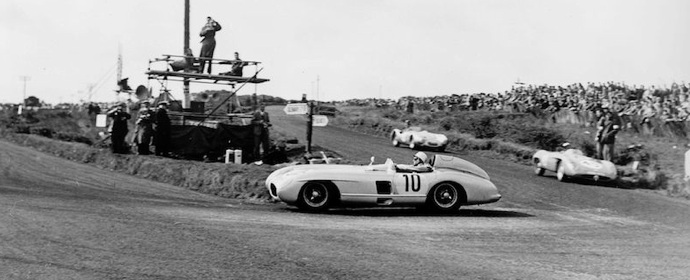
By Art Evans
The Tourist Trophy is the oldest motor race in the world still being run. The first was in 1905 on the Isle of Man, organized by the Automobile Club of Great Britain and Ireland. The trophy itself is given by the Royal Automobile Club to the winner.
Over the years, Tourist Trophy races have been part of the World Manufacturers Championship, the World Touring Car Championship, the European Touring Car Championship, the International Sports Racing Series, the FIA GT Championship and the British Touring Car Championship.
Although the first six were held on the Isle of Man, afterwards they moved to various other locations in Northern Ireland and England. TTs, as they are called, were not held during war years and, in addition, there were some other years without events. In all, a total of 66 have been run including 2011. For many of those years, the TT has been Britain’s foremost motor race.
Some of the world’s best racing drivers have taken part including Rudolf Caracciola and Tazio Nuvolari. Stirling Moss won it seven times! Americans Carroll Shelby and John Fitch are also among the winners.
As the name implies, the TT is for touring automobiles, although there was an interlude for sports cars and even briefly for grand prix cars. In recent years, it has been for touring vehicles. During the early years of racing, the British government did not allow racing on public roads, so there was no racing there until a purpose-built course—Brooklands—was opened in 1907. Although part of Great Britain, Northern Ireland and the Isle of Man had their own laws that permitted closing public roads for racing. So both were used for this purpose.
The first race on the Isle of Man was in 1904. Not billed as a Tourist Trophy, it was an “Elimination Trial” for the Gordon Bennett Cup event held that year. It was five laps over a 52.15-mile course won by Clifford Earl in a Napier. The Trial was held again in 1905 over the same course and again won by Earl.
As an aside, it should be noted that motorcycle races were also run on the Isle of Man. The day after the 1905 Gordon Bennett Elimination Trial, there was an elimination trial to establish a team to represent Great Britain in the International Motorcycle Cup races.
The very first RAC Tourist Trophy took place the following September, again over the same course. (Called the “Highland Course). John Napier won in six hours and nine minutes with an average speed of 33.90 mph. Regulations required a vehicle weight between 1,300 and 1,600 pounds, a wheelbase of at least seven feet, six inches and a load weight of 660 pounds consisting of driver, mechanic (or passenger) and sand ballast. Entries had to accommodate the driver and three passengers (i.e., have a back seat). Examples of the same car had to be available for sale to the public for at least a month after the event.
Forty-two cars started the race. Twenty-eight were made in England. Sixteen of the English cars finished plus two from other countries. The race was four laps over the Highland Course. Charles Rolls was a pre-race favorite, but Napier in his 3.8-liter Arrol-Johnson finished first by two minutes and nine seconds over a Rolls-Royce driven by Percy Northey. Rolls had stripped his gears shortly after the start. Napier set the fastest lap of one hour, 31 minutes and nine seconds at 34.30 mph.
The RAC decided to have a second event the following year. This time, the Isle of Man course was shortened to 40.25 miles. Charles Rolls won in a more powerful 22-hp model. In 1907, the RAC ran two races, one for lighter, the other for heavier cars. The “Heavy Tourist” was run during a storm. It covered only five laps, but even so, just two cars finished. In 1908 the course was reduced to 37.75 miles in the interest of safety.
For some reason, in 1908, 1914 and 1922, grand prix (open wheel) cars were allowed to compete. There were no TTs during 1909-1913. In 1914, the event was run over two days; each day an eight lapper. For the first time, there were cash prizes with 1,000 pounds to the winner. (A considerable sum in those days).
World War I intervened and there was no race in 1915. The next was in 1922 and then there wasn’t another until 1928. World War II came along, so there were none between 1939 and 1949.

History of the Tourist Trophy – Race Profile Continued
History of the Tourist Trophy – Page Two
During the period 1928 through 1959 and again from 1964 through 1969, production sports cars were allowed to run, even though it was still called the Tourist Trophy. A handicapping system was used so that, in theory at least, tourers had an even chance. Sports cars were allowed again from 1998 through 2001. Otherwise, TTs have been for Touring Cars except in recent years—starting in 2005—when they have been for Grand Tourers.
In 1928, the event moved off of the Isle of Man to Northern Ireland using what was called, the Ards circuit. It was 13.6 miles around an irregular triangle on public roads. An accident in which eight spectators were killed during the 1936 race spelled the end of the Ards circuit. In 1937 and again in 1938, TTs were held at Donnington Park, a 3.125-mile purpose-built course. Starting in 1950 and ending after 1955, the events went back to Northern Ireland using what is called the Dundrod Circuit , 7.42 miles of narrow, twisty public roads. Although potentially dangerous, it was the only place the RAC could find to lay out a true road course. At the first race after WWII—1950—21-year-old Stirling Moss demonstrated his potential, winning in an XK120 Jaguar. He repeated the next year, this time in a C-Type Jaguar.
Perhaps the most noteworthy year was 1955, the year of the horrendous tragedy at Le Mans . For one thing, it was Golden Jubilee year for the Tourist Trophy. Also, it was one of the events that decided the World Manufacturers Championship. Fifteen manufacturers entered including those in the run for the championship: Ferrari, Mercedes-Benz, Jaguar and Porsche. John Fitch called parts of Dundrod “narrow and treacherous.” In Racing With Mercedes , he wrote that, “I’d considered it extremely dangerous when I competed there in 1953 and found no reason in 1955 to change my opinion.” On the second lap, Jim Mayers in a Cooper crashed and was killed, as was Bill Smith in a Connaught. Later in the race, Richard Mainwaring was killed when his Elva overturned. Mike Hawthorn and Desmond Tittering were leading on the last lap in their Jaguar when the engine blew. Stirling Moss and John Fitch took the checker in a 300SLR. The Tourist Trophy was never held at Dundrod again. After Moss and Peter Collins won the final race—the Targa Floria—Mercedes-Benz won the Championship.

In 1956 and the following year, there were no TTs, but from 1958 on, all have been on purpose-built courses in England. Goodwood, Oulton Park, Silverstone and Donnington Park, all have hosted England’s premier race. In 1958, Carroll Shelby, with co-driver Steward Lewis-Evans, was third in an Aston Martin and the next year, Shelby, with Jack Fairman and Stirling Moss won in the same marque. In recent years, TTs have been at Silverstone including 2011 when Michael Krumm and Lucas Luhr won in a Nissan GT-R GT1.
[Source: Art Evans]

Bugatti Chiron Super Sport 300+ To Be Auctioned By Bonhams

RM Sotheby’s To Auction A McLaren P1 And Porsche 918 Spyder Both Finished In Blue

A Pair Of Mercedes-Benz CLK GTRs Is Heading To RM Sotheby’s Las Vegas Auction

FOR SALE: 1995 Ferrari F50

FOR SALE: 2006 Ford GT
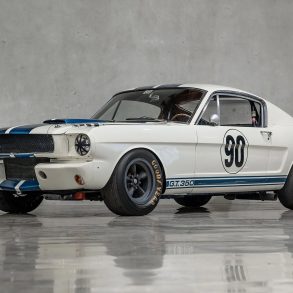
FOR SALE: 1965 Shelby GT350 R
I believe that the oldest race in the world is the Shelsley Walsh Hill climb.The Tourist Trophy is a revived title these days.
Shelsley Walsh may be an older event, but it isn’t a race, it’s a time trial.
Sir Stirling Moss is the King ! Thanks for this article Love it !
can anyone find out the registration number for Lee Guinness Darracq (#4) please
Thanks for the memories – The ’55 Ulster TT is the first race that I ever attended with my father at the age of 11. Talk about a case of sensual overload!
Leave a Reply Cancel reply
You must be logged in to post a comment.
- Free Newsletter
Get Our Free Weekly Newsletter


1907 Isle of Man TT - first motorcycle race
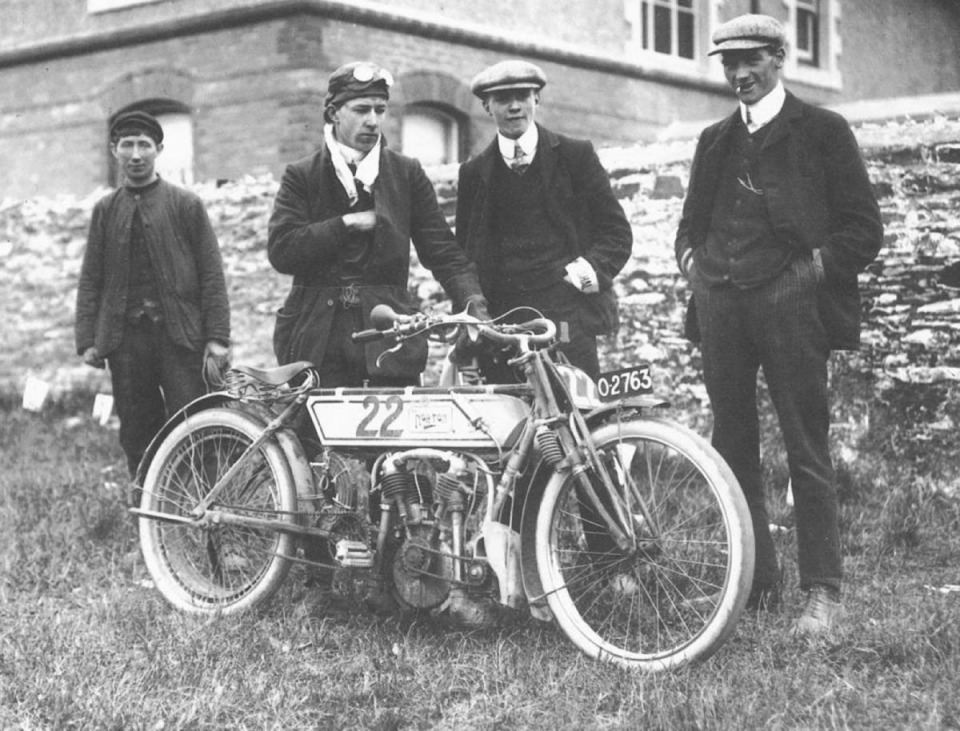
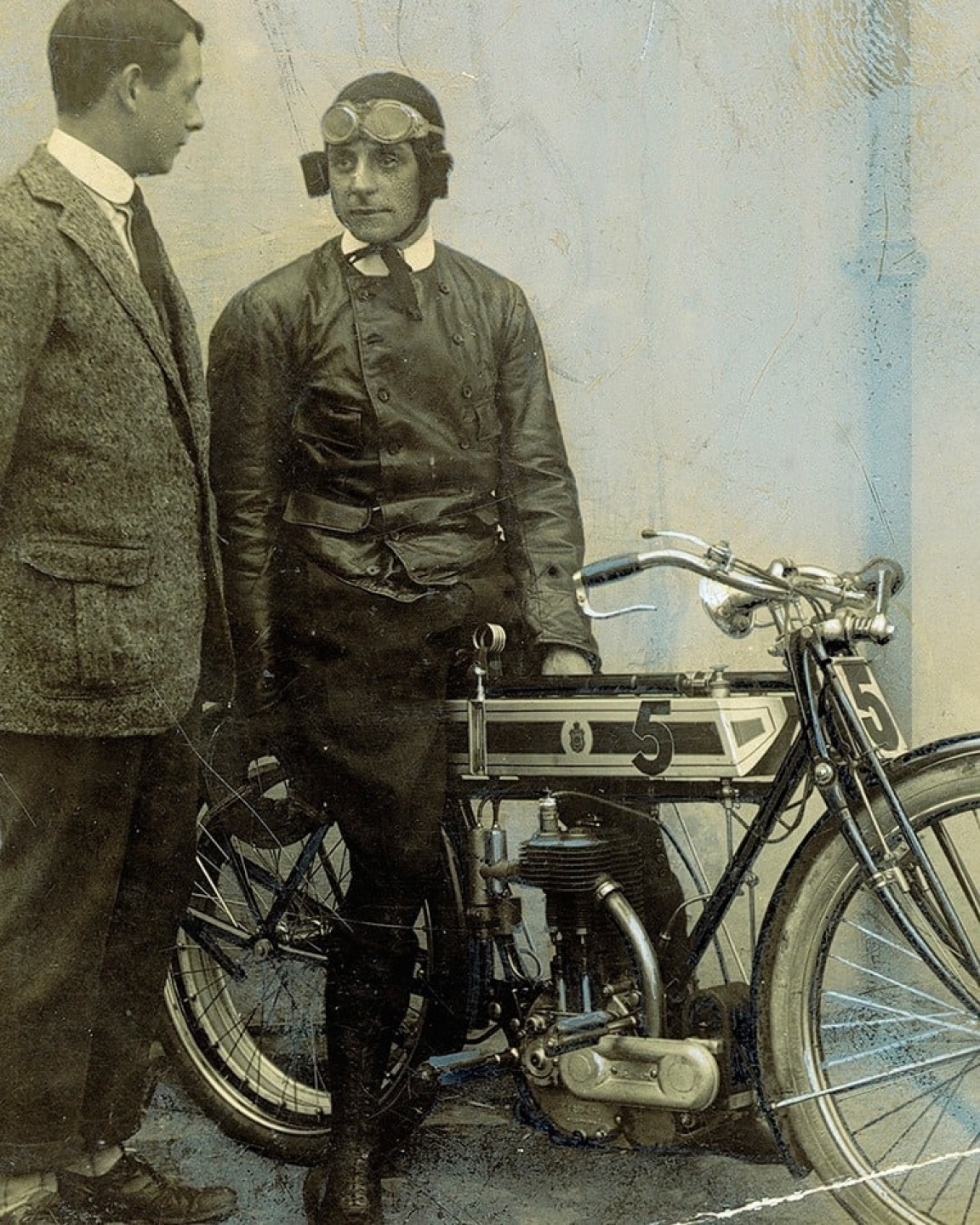
- Post Adding a post to a personal blog or motoblog
- Bike Adding a motorcycle to the garage
- Event or Group Ride Create an event or a route for ride
Grace's Guide To British Industrial History
Grace's Guide is the leading source of historical information on industry and manufacturing in Britain. This web publication contains 162,636 pages of information and 244,525 images on early companies, their products and the people who designed and built them.

Grace's Guide is the leading source of historical information on industry and manufacturing in Britain. This web publication contains 147,919 pages of information and 233,587 images on early companies, their products and the people who designed and built them.
1907 Tourist Trophy Race
The third Tourist Trophy Race was held in the Isle of Man on the 31st May 1907. Friday.
The race was won by Ernest Courtis in a 20hp Rover
The 'Graphic' Trophy Race was also held on Slein Lewaigne Hill, near Ramsey over a hill climbing course of 2,550 yards. Barwick (Daimler) crashed in practice on Thursday. Bolton (Daimler) crashed in the race at the same place. Later an Ariel-Simplex crashed at the same place. Results were: Ernest Hutton (Berliet); Watson ( Berliet ); Daimler ; Junior ; Ariel-Simplex ; Porperato ( Berliet ); Hillman-Coatalen . [1]
Sources of Information
- ↑ The Times (London, England), Saturday, June 1, 1907
- The Times, Saturday, Jun 01, 1907
- Automobile Races
Grace's Guide web site design is Copyright © 2021 by Grace's Guide Ltd. The text of this web site is available under the Creative Commons Attribution-ShareAlike License ; additional terms may apply. By using this site, you agree to the Terms of Use and Privacy Policy . Maintained by Sapere Software
- Motorcycles
- Rally/Rallycross
- Single-seaters
- Touring Cars
- ANNIVERSARIES
- ACKNOWLEDGEMENTS
Isle of Man Tourist Trophy (1907-to date)
1907 – St John’s Course (May 28) Single cyclinder: Charlie Collier (GB)-Matchless Twin cylinder: Rem Fowler (GB)-Norton
1908 – St John’s Course (Sep 22) Single cyclinder: Jack Marshall (GB)-Triumph Twin cylinder: Harry Reed (GB)-DOT
1909 – St John’s Course (Sep 23) 500cc single/750cc twin cylinder: Harry Collier (GB)-Matchless
1910 – St John’s Course (May 26) 500cc single/750cc twin cylinder: Charlie Collier (GB)-Matchless
1911 – Mountain Course (Jun 30-Jul 3) Junior 350cc: Percy Evans (GB)-Humber Senior 500cc: Oliver Godfrey (GB)-Indian
1912 – Mountain Course (Jun 28-Jul 1) Junior 350cc: Harry Bashall (GB)-Douglas Senior 500cc: Frank Applebee (GB)-Scott
1913 – Mountain Course (Jun 4-6) Junior 350cc: Hugh Mason (GB)-NUT Senior 500cc: Tim Wood (GB)-Scott
1914 – Mountain Course (May 19-21) Junior: Eric Williams (GB)-AJS Senior: Cyril Pullin (GB)-Rudge
1915-1919 NO EVENT
1920 – Mountain Course (Jun 15-16) Junior: Cyril Williams (GB)-AJS Senior: Tommy de la Hay (GB)-Sunbeam
1921 – Mountain Course (Jun 14-16) Junior: Eric Williams (GB)-AJS Senior: Howard Davies (GB)-AJS
1922 – Mountain Course (May 30) Junior: Tom Sheard (GB)-AJS Lightweight: Geoff Davison (GB)-Levis Senior: Alec Bennett (GB)-Sunbeam
1923 – Mountain Course (Jun 15) Junior: Stanley Woods (IRL)-Cotton Lightweight: Jack Porter (GB)-New Gerrard Senior: Tom Sheard (GB)-Douglas Sidecar: Freddie Dixon (GB)/Walter Denny (GB)-Douglas
1924 – Mountain Course (Jun 27) Junior: Kenneth Twemlow (GB)-New Imperial Lightweight: Edwin Twemlow (GB)-New Imperial Senior: Alec Bennett (GB)-Norton Sidecar: George Tucker (GB)-Norton Ultra Lightweight: Jack Porter (GB)-New Gerrard
1925 – Mountain Course (Jun 17) Junior: Wal Handley (GB)-Rex-Acme Lightweight: Edwin Twemlow (GB)-New Imperial Senior: Howard Davies (GB)-HRD Sidecar: Len Parker (GB)/Ken Horstman (GB)-Douglas Ultra Lightweight: Wal Handley (GB)-Rex-Acme
1926 – Mountain Course (Jun 18) Junior: Alec Benett (GB)-Velocette Lightweight: Paddy Johnston (GB)-Cotton Senior: Stanley Woods (IRL)-Norton
1927 – Mountain Course (Jun 17) Junior: Freddie Dixon (GB)-HRD Lightweight: Wal Handley (GB)-Rex-Acme Senior: Alec Benett (GB)-Norton
1928 – Mountain Course (Jun 8) Junior: Alec Benett (GB)-Velocette Lightweight: Frank Longman (GB)-OK-Supreme Senior: Charlie Dodson (GB)-Sunbeam
1929 – Mountain Course (Jun 14) Junior: Freddie Hicks (GB)-Velocette Lightweight: Syd Crabtree (GB)-Excelsior Senior: Charlie Dodson (GB)-Sunbeam
1930 – Mountain Course (Jun 16-20) Junior: Henry Tyrell Smith (IRL)-Rudge Lightweight: Jimmy Guthrie (GB)-AJS Senior: Wal Handley (GB)-Rudge
1931 – Mountain Course (Jun 19) Junior: Percy Hunt (IRL)-Norton Lightweight: Graham Walker (GB)-Rudge Senior: Percy Hunt (GB)-Norton
1932 – Mountain Course (Jun 10) Junior: Stanley Woods (IRL)-Norton Lightweight: Leo Davenport (GB)-New Imperial Senior: Stanley Woods (IRL)-Norton
1933 – Mountain Course (Jun 16) Junior: Stanley Woods (IRL)-Norton Lightweight: Sid Gleave (GB)-Excelsior Senior: Stanley Woods (IRL)-Norton
1934 – Mountain Course (Jun 15) Junior: Jimmy Guthrie (GB)-Norton Lightweight: Jimmy Simpson (GB)-Rudge Senior: Jimmy Guthrie (GB)-Norton
1935 – Mountain Course (Jun 17-22) Junior: Jimmy Guthrie (GB)-Norton Lightweight: Stanley Woods (IRL)-Moto Guzzi Senior: Stanley Woods (IRL)-Moto Guzzi
1936 – Mountain Course (Jun 16-19) Junior: Freddie Frith (GB)-Norton Lightweight: Bob Foster (GB)-New Imperial Senior: Jimmy Guthrie (GB)-Norton
1937 – Mountain Course (Jun 18) Junior: Jimmy Guthrie (GB)-Norton Lightweight: Omobono Tenni (I)-Moto Guzzi Senior: Freddie Frith (GB)-Norton
1938 – Mountain Course (Jun 17) Junior: Stanley Woods (IRL)-Velocette Lightweight: Ewald Kluge (A)-DKW Senior: Harold Daniell (GB)-Norton
1939 – Mountain Course (Jun 12-16) Junior: Stanley Woods (IRL)-Velocette Lightweight: Ted Mellors (GB)-Benelli Senior: Georg Meier (D)-BMW
1940-1946 NO EVENT
1947 – Mountain Course (Jun 13) Clubmans Junior: Denis Parkinson (GB)-Norton Clubmans Lightweight: Basil Keys (GB)-AJS Clubmans Senior: Eric Briggs (GB)-Norton Junior: Bob Foster (GB)-Velocette Lightweight: Manliffe Barrington (IRL)-Moto Guzzi Senior: Harold Daniell (GB)-Norton
1948 – Mountain Course (Jun 11) Clubmans Junior: Ronnie Hazlehurst (GB)-Velocette Clubmans Lightweight: Monty Lockwood (GB)-Excelsior Clubmans Senior: Jack Daniells (GB)-Vincent HRD Junior: Freddie Frith (GB)-Velocette Lightweight: Maurice Cann (GB)-Moto Guzzi Senior: Artie Bell (GB)-Norton
1949 – Mountain Course (Jun 13-17) Clubmans 1000cc: Dennis Lashmar (GB)-Vincent Clubmans Junior: Harold Clark (GB)-BSA Clubmans Lightweight: Cyril Taft (GB)-Excelsior Clubmans Senior: Geoff Duke (GB)-Norton Junior: Freddie Frith (GB)-Velocette Lightweight: Manliffe Barrington (IRL)-Moto Guzzi Senior: Harold Daniell (GB)-Norton
1950 – Mountain Course (Jun 5-9) Clubmans 1000cc: Alex Phillip (GB)-Vincent HRD Clubmans Junior: Brian Jackson (GB)-BSA Clubmans Lightweight: Frank Fletcher (GB)-Excelsior Clubmans Senior: Phil Carter (GB)-Norton Junior: Artie Bell (GB)-Norton Lightweight: Dario Ambrosini (I)-Benelli Senior: Geoff Duke (GB)-Norton
1951 – Mountain Course (Jun 6-8) Clubmans Junior: Brian Purslow (GB)-BSA Clubmans Senior: Ken Arber (GB)-Triumph Junior: Geoff Duke (GB)-Norton Lightweight: Tommy Wood (GB)-Moto Guzzi Senior: Geoff Duke (GB)-Norton Ultra Lightweight: Cromie McCandless (GB)-Mondial
1952 – Mountain Course (Jun 11-13) Clubmans Junior: Eric Houseley (GB)-BSA Clubmans Senior: Bernard Hargreaves (GB)-Triumph Junior: Geoff Duke (GB)-Norton Lightweight 250cc: Fergus Anderson (GB)-Moto Guzzi Senior: Reg Armstrong (IRL)-Norton Ultra Lightweight: Cecil Sandford (GB)-MV Agusta
1953 – Mountain Course (Jun 8-12) Clubmans 1000cc: George Douglas (GB)-Vincent Clubmans Junior: Derek Powell (GB)-BSA Clubmans Senior: Bob Keeler (GB)-Norton Junior: Ray Amm (RHO)-Norton Lightweight 125cc: Les Graham (GB)-MV Agusta Lightweight 250cc: Fergus Anderson (GB)-Moto Guzzi Senior: Ray Amm (RHO)-Norton
1954 – Mountain Course (Jun 14-19) Clubmans Junior: Philip Palmer (GB)-BSA Clubmans Senior: Alistair King (GB)-BSA Junior: Rod Coleman (NZ)-AJS Lightweight: Werner Haas (D)-NSU Senior: Ray Amm (RHO)-Norton Sidecar (Clypse Course): Eric Oliver (GB)/Les Nutt (GB)-Norton Ultra Lightweight (Clypse Course): Rupert Hollaus (A)-NSU
1955 – Mountain Course (Jun 8-10) Clubmans Junior (Clypse Course): Jimmy Buchan (GB)-BSA Clubmans Senior (Clypse Course): Eddie Dow (GB)-BSA Junior: Bill Lomas (GB)-Moto Guzzi Lightweight 125 (Clypse Course): Carlo Ubbiali (I)-MV Agusta Lightweight 250 (Clypse Course): Bill Lomas (GB)-MV Agusta Senior: Geoff Duke (GB)-Gilera Sidecar (Clypse Course): Walter Schneider (D)/Hans Strauss (D)-BMW
1956 – Mountain Course (Jun 6-8) Clubmans Junior: Bernard Codd (GB)-BSA Clubmans Senior: Bernard Codd (GB)-BSA Junior: Ken Kavanagh (AUS)-Moto Guzzi Lightweight 125 (Clypse Course): Carlo Ubbiali (I)-MV Agusta Lightweight 250 (Clypse Course): Carlo Ubbiali (I)-MV Agusta Senior: John Surtees (GB)-MV Agusta Sidecar (Clypse Course): Fritz Hillebrand (D)/Manfred Grunwald (D)-BMW
1957 – Mountain Course (Jun 5-7) Junior: Bob McIntyre (GB)-Gilera Lightweight (Clypse Course): Cecil Sandford (GB)-Mondial Senior: Bob McIntyre (GB)-Gilera Sidecar (Clypse Course): Fritz Hillebrand (D)/Manfred Grunwald (D)-BMW Ultra Lightweight (Clypse Course): Tarquinio Provini (I)-Mondial
1958 – Mountain Course (Jun 2-6) Junior: John Surtees (GB)-MV Agusta Lightweight (Clypse Course): Tarquinio Provini (I)-MV Agusta Senior: John Surtees (GB)-MV Agusta Sidecar (Clypse Course): Walter Schneider (D)/Hans Strauss (D)-BMW Ultra Lightweight (Clypse Course): Carlo Ubbiali (I)-MV Agusta
1959 – Mountain Course (May 30-Jun 6) Formula One 350cc: Alistair King (GB)-AJS Formula One 500cc: Bob McIntyre (GB)-Norton Junior: John Surtees (GB)-MV Agusta Lightweight (Clypse Course): Tarquinio Provini (I)-MV Agusta Senior: John Surtees (GB)-MV Agusta Sidecar (Clypse Course): Walter Schneider (D)/Hans Strauss (D)-BMW Ultra Lightweight (Clypse Course): Tarquinio Provini (I)-MV Agusta
1960 – Mountain Course (Jun 13-17) Junior: John Hartle (GB)-MV Agusta Lightweight: Gary Hocking (RHO)-MV Agusta Senior: John Surtees (GB)-MV Agusta Sidecar: Helmut Fath (D)/Alfred Wohlgemuth (D)-BMW Ultra Lightweight: Carlo Ubbiali (I)-MV Agusta
1961 – Mountain Course (May 12-16) Junior: Phil Read (GB)-Norton Lightweight 125cc: Mike Hailwood (GB)-Honda Lightweight 250cc: Mike Hailwood (GB)-Honda Senior: Mike Hailwood (GB)-Norton Sidecar: Max Deubel (D)/Emil Hoerner (D)-BMW
1962 – Mountain Course (Jun 4-8) 50cc: Ernst Degner (D)-Suzuki Junior: Mike Hailwood (GB)-MV Agusta Lightweight 125cc: Luigi Taveri (CH)-Honda Lightweight 250cc: Derek Minter (D)-Honda Senior: Gary Hocking (RHO)-MV Agusta Sidecar: Chris Vincent (GB)/Eric Bliss (GB)-BSA
1963 – Mountain Course (Jun 10-14) 50cc: Mitsui Itoh (J)-Suzuki Junior: Jim Redman (RHO)-Honda Lightweight 125cc: Hugh Anderson (NZ)-Suzuki Lightweight 250cc: Jim Redman (RHO)-Honda Senior: Mike Hailwood (GB)-MV Agusta Sidecar: Florian Camathias (CH)/Alfred Herzig (CH)-BMW
1964 – Mountain Course (Jun 8-12) 50cc: Hugh Anderson (NZ)-Suzuki Junior: Jim Redman (RHO)-Honda Lightweight 125cc: Luigi Taveri (CH)-Honda Lightweight 250cc: Jim Redman (RHO)-Honda Senior: Mike Hailwood (GB)-MV Agusta Sidecar: Max Deubel (D)/Emil Hoerner (D)-BMW
1965 – Mountain Course (Jun 14-18) 50cc: Luigi Taveri (CH)-Honda Junior: Jim Redman (RHO)-Honda Lightweight 125cc: Phil Read (GB)-Yamaha Lightweight 250cc: Jim Redman (RHO)-Honda Senior: Mike Hailwood (GB)-MV Agusta Sidecar: Max Deubel (D)/Emil Hoerner (D)-BMW
1966 – Mountain Course (Aug 28-Sep 2) 50cc: Ralph Bryans (GB)-Honda Junior: Giacomo Agostini (I)-MV Agusta Lightweight 125cc: Bill Ivy (GB)-Yamaha Lightweight 250cc: Mike Hailwood (GB)-MV Agusta Senior: Mike Hailwood (GB)-MV Agusta Sidecar: Fritz Scheidegger (CH)/John Robinson (GB)-BMW
1967 – Mountain Course (Jun 12-16) 50cc: Stuart Graham (GB)-Suzuki Lightweight 125cc: Phil Read (GB)-Yamaha Lightweight 250cc: Mike Hailwood (GB)-Honda Junior: Mike Hailwood (GB)-Honda Production 250cc: Bill Smith (GB)-Bultaco Production 500cc: Neil Kelly (GB)-Velocette Production 750cc: John Hartle (GB)-Triumph Senior: Mike Hailwood (GB)-Honda Sidecar: Siegfried Schauzu (D)/Horst Schneider (D)-BMW
1968 – Mountain Course (Jun 8-14) 50cc: Barry Smith (AUS)-Derbi Lightweight 125cc: Phil Read (GB)-Yamaha Lightweight 250cc: Bill Ivy (GB)-Yamaha Junior: Giacomo Agostini (I)-MV Agusta Production 250cc: Trevor Burgess (GB)-Ossa Production 500cc: Ray Knight (GB)-Triumph Production 750cc: Ray Pickrell (GB)-Dunstall Norton Senior: Giacomo Agostini (I)-MV Agusta Sidecar 500cc: Siegfried Schauzu (D)/Horst Schneider (D)-BMW Sidecar 750cc: Terry Vinicombe (GB)/John Flaxman (GB)-BSA
1969 – Mountain Course (Jun 7-13) Lightweight 125cc: Dave Simmonds (GB)-Kawasaki Lightweight 250cc: Kel Carruthers (AUS)-Benelli Junior: Giacomo Agostini (I)-MV Agusta Production 250cc: Alastair Rogers (GB)-Ducati Production 500cc: Graham Penny (GB)-Honda Production 750cc: Malcolm Uphill (GB)-Triumph Senior: Giacomo Agostini (I)-MV Agusta Sidecar 500cc: Klaus Enders (D)/Ralf Engelhardt (D)-BMW Sidecar 750cc: Siegfried Schauzu (D)/Horst Schneider (D)-BMW
1970 – Mountain Course (Jun 8-12) Lightweight 125cc: Dieter Braun (D)-Suzuki Lightweight 250cc: Kel Carruthers (AUS)-Yamaha Junior: Giacomo Agostini (I)-MV Agusta Production 250cc: Chas Mortimer (GB)-Ducati Production 500cc: Frank Whiteway (GB)-Suzuki Production 750cc: Malcolm Uphill (GB)-Triumph Senior: Giacomo Agostini (I)-MV Agusta Sidecar 500cc: Klaus Enders (D)/Wolfgang Kalauch (D)-BMW Sidecar 750cc: Siegfried Schauzu (D)/Horst Schneider (D)-BMW
1971 – Mountain Course (Jun 6-13) Formula 750cc: Tony Jefferies (GB)-Triumph Lightweight 125cc: Chas Mortimer (GB)-Yamaha Lightweight 250cc: Phil Read (GB)-Yamaha Junior: Tony Jefferies (GB)-Yamsel Production 250cc: Bill Smith (GB)-Honda Production 500cc: John Williams (GB)-Honda Production 750cc: Ray Pickrell (GB)-Triumph Senior: Giacomo Agostini (I)-MV Agusta Sidecar 500cc: Siegfried Schauzu (D)/Wolfgang Kalauch (D)-BMW Sidecar 750cc: Georg Auerbacher (D)/Hermann Hahn (D)-BMW
1972 – Mountain Course (Jun 8-9) Formula 750cc: Ray Pickrell (GB)-Triumph Lightweight 125cc: Chas Mortimer (GB)-Yamaha Lightweight 250cc: Phil Read (GB)-Yamaha Junior: Giacomo Agostini (I)-MV Agusta Production 250cc: John Williams (GB)-Honda Production 500cc: Stan Woods (GB)-Suzuki Production 750cc: Ray Pickrell (GB)-Triumph Senior: Giacomo Agostini (I)-MV Agusta Sidecar 500cc: Siegfried Schauzu (D)/Wolfgang Kalauch (D)-BMW Sidecar 750cc: Siegfried Schauzu (D)/Wolfgang Kalauch (D)-BMW
1973 – Mountain Course (Jun 6-8) Formula 750cc: Peter Williams (GB)-Norton Lightweight 125cc: Tommy Robb (GB)-Yamaha Lightweight 250cc: Charlie Williams (GB)-Yamaha Junior: Tony Rutter (GB)-Yamaha Production 250cc: Charlie Williams (GB)-Yamaha Production 500cc: Bill Smith (GB)-Honda Production 750cc: Tony Jefferies (GB)-Triumph Senior: Jack Findlay (GB)-Suzuki Sidecar 500cc: Klaus Enders (D)/Ralf Engelhardt (D)-BMW Sidecar 750cc: Klaus Enders (D)/Ralf Engelhardt (D)-BMW
1974 – Mountain Course (Jun 5-6) Lightweight 125cc: Charlie Williams (GB)-Yamaha Lightweight 250cc: Charlie Williams (GB)-Yamaha Junior: Tony Rutter (GB)-Yamaha Production 250cc: Martyn Sharpe (GB)-Yamaha Production 500cc: Keith Martin (GB)-Kawasaki Production 1000cc: Mick Grant (GB)-Triumph Senior: Phil Carpenter (GB)-Yamaha Sidecar 500cc: Heinz Luthringshauser (D)/Hermann Hahn (D)-BMW Sidecar 750cc: Siegfried Schauzu (D)/Wolfgang Kalauch (D)-BMW
1975 – Mountain Course (Jun 1-7) Classic: John Williams (GB)-Yamaha Lightweight 250cc: Chas Mortimer (GB)-Yamaha Junior: Charlie Williams (GB)-Yamaha Production: Dave Croxford (GB)-Triumph Senior: Mick Grant (GB)-Kawasaki Sidecar 500cc: Rolf Steinhausen (D)/Josef Huber (D)-Konig Sidecar 1000cc: Siegfried Schauzu (D)/Wolfgang Kalauch (D)-BMW
1976 – Mountain Course (Jun 7-11) Classic: John Williams (GB)-Suzuki Lightweight 250cc: Tom Herron (GB)-Yamaha Junior: Chas Mortimer (GB)-Yamaha Production: Bill Simpson (GB)-Yamaha Senior: Tom Herron (GB)-Yamaha Sidecar 500cc: Rolf Steinhausen (D)/Josef Huber (D)-Konig Sidecar 1000cc: Mac Hobson (GB)/Mick Burns (GB)-Yamaha
1977 – Mountain Course (DATE) Classic: Mick Grant (GB)-Kawasaki Formula One: Phil Read (GB)-Honda Formula Two: Alan Jackson Jr (GB)-Honda Formula Three: John Kidson (GB)-Honda Jubilee: Joey Dunlop (GB)-Yamaha Junior 250cc: Charlie Williams (GB)-Yamaha Senior: Phil Read (GB)-Suzuki Sidecar, Race 1: George O’Dell (GB)/Kenny Arthur (GB)-Yamaha Sidecar, Race 2: Mac Hobson (GB)/Stuart Collins (GB)-Yamaha
1978 – Mountain Course (DATE) Classic: Mick Grant (GB)-Kawasaki Formula One: Mike Hailwood (GB)-Ducati Formula Two: Alan Jackson Jr (GB)-Honda Formula Three: Bill Smith (GB)-Honda Junior: Chas Mortimer (GB)-Yamaha Senior: Tom Herron (GB)-Suzuki Sidecar, Race 1: Dick Greasley (GB)/Gordon Russell (GB)-Yamaha Sidecar, Race 2: Rolf Steinhausen (D)/Wolfgang Kalauch (D)-Yamaha
1979 – Mountain Course (DATE) Classic: Alex George (GB)-Honda Formula One: Alex George (GB)-Honda Formula Two: Alan Jackson Jr (GB)-Honda Formula Three: Barry Smith (GB)-Yamaha Junior 250cc: Charlie Williams (GB)-Maxton Yamaha Senior: Mike Hailwood (GB)-Suzuki Sidecar, Race 1: Trevor Ireson (GB)/Clive Pollington (GB)-Yamaha Sidecar, Race 2: Trevor Ireson (GB)/Clive Pollington (GB)-Yamaha
1980 – Mountain Course (DATE) Classic: Joey Dunlop (GB)-Yamaha Formula One: Mick Grant (GB)-Honda Formula Two: Charlie Williams (GB)-Yamaha Formula Three: Barry Smith (GB)-Yamaha Junior: Charlie Williams (GB)-Yamaha Senior: Graeme Crosby (NZ)-Suzuki Sidecar, Race 1: Trevor Ireson (GB)/Clive Pollington (GB)-Yamaha Sidecar, Race 2: Jock Taylor (GB)/Benga Johansson (S)-Yamaha
1981 – Mountain Course (DATE) Classic: Graeme Crosby (NZ)-Suzuki Formula One: Graeme Crosby (NZ)-Suzuki Formula Two: Tony Rutter (GB)-Ducati Formula Three: Barry Smith (GB)-Yamaha Junior: Steve Tonkin (GB)-Armstrong Senior: Mick Grant (GB)-Suzuki Sidecar, Race 1: Jock Taylor (GB)/Benga Johansson (S)-Yamaha Sidecar, Race 2: Jock Taylor (GB)/Benga Johansson (S)-Yamaha
1982 – Mountain Course (DATE) Classic: Denis Ireland (NZ)-Suzuki Formula One: Ron Haslam (GB)-Honda Formula Two: Tony Rutter (GB)-Ducati Formula Three: Gary Padgett (GB)-Yamaha Junior: Con Law (GB)-Waddon Senior 350cc: Tony Rutter (GB)-Yamaha Senior 500cc: Norman Brown (GB)-Suzuki Sidecar, Race 1: Trevor Ireson (GB)/Don Williamson (GB)-Yamaha Sidecar, Race 2: Jock Taylor (GB)/Benga Johansson (S)-Yamaha
1983 – Mountain Course (DATE) Formula One: Joey Dunlop (GB)-Honda Formula Two: Tony Rutter (GB)-Ducati Junior: Con Law (GB)-EMC Junior 350cc: Phil Mellor (GB)-Yamaha Senior Classic: Rob McElnea (GB)-Suzuki Sidecar, Race 1: Dick Greasley (GB)/Stewart Atkinson (GB)-Yamaha Sidecar, Race 2: Mick Boddice (GB)/Chas Birks (GB)-Yamaha
1984 – Mountain Course (DATE) Classic: Rob McElnea (GB)-Suzuki Formula One: Joey Dunlop (GB)-Honda Formula Two: Graeme McGregor (GB)-Yamaha Historic 350cc: Steve Cull (GB)-Aermacchi Historic 500cc: Dave Roper (GB)-Matchless Junior: Graeme McGregor (GB)-EMC Production 100-250cc: Phil Mellor (GB)-Yamaha Production 251-750cc: Trevor Nation (GB)-Honda Production 751-1500cc: Geoff Johnson (GB)-Kawasaki Senior: Rob McElnea (GB)-Suzuki Sidecar, Race 1: Mick Boddice (GB)/Chas Birks (GB)-Yamaha Sidecar, Race 2: Steve Abbott (GB)/Shaun Smith (GB)-Yamaha
1985 – Mountain Course (DATE) Formula One: Joey Dunlop (GB)-Honda Formula Two: Tony Rutter (GB)-Ducati Junior: Joey Dunlop (GB)-Honda Production 100-250cc: Mat Oxley (GB)-Honda Production 251-750cc: Mick Grant (GB)-Suzuki Production 751-1500cc: Geoff Johnson (GB)-Honda Senior: Joey Dunlop (GB)-Honda Sidecar, Race 1: Dave Hallam (GB)/John Gibbard (GB)-Yamaha Sidecar, Race 2: Mick Boddice (GB)/Chas Birks (GB)-Yamaha
1986 – Mountain Course (DATE) Formula One: Joey Dunlop (GB)-Honda Formula Two: Brian Reid (GB)-Yamaha Junior: Steve Cull (GB)-Honda Production Class A: Trevor Nation (GB)-Suzuki Production Class B: Phil Mellor (GB)-Suzuki Production Class C: Gary Padgett (GB)-Suzuki Production Class D: Barry Woodland (GB)-Suzuki Senior: Roger Burnett (GB)-Honda Sidecar, Race 1: Lowry Burton (GB)/Pat Cushnahan (GB)-Yamaha Sidecar, Race 2: Nigel Rollason (GB)/Don Williams (GB)-Barton Phoenix
1987 – Mountain Course (DATE) Formula One: Joey Dunlop (GB)-Honda Formula Two: Steve Hislop (GB)-Yamaha Junior 250cc: Eddie Laycock (GB)-EMC Production Class B: Geoff Johnson (GB)-Yamaha Production Class D: Barry Woodland (GB)-Yamaha Senior: Joey Dunlop (GB)-Honda Sidecar, Race 1: Mick Boddice (GB)/Don Williams (GB)-Yamaha Sidecar, Race 2: Lowry Burton (GB)/Pat Cushnahan (GB)-Yamaha
1988 – Mountain Course (DATE) Formula One: Joey Dunlop (GB)-Honda Junior: Joey Dunlop (GB)-Honda Production Class A: Dave Leach (GB)-Yamaha Production Class B: Steve Hislop (GB)-Honda Production Class C: Brian Morrison (GB)-Honda Production Class D: Barry Woodland (GB)-Yamaha Senior: Joey Dunlop (GB)-Honda Sidecar, Race 1: Mick Boddice (GB)/Chas Birks (GB)-Yamaha Sidecar, Race 2: Mick Boddice (GB)/Chas Birks (GB)-Yamaha
1989 – Mountain Course (DATE) Formula One: Steve Hislop (GB)-Honda Junior: Johnny Rea (GB)-Yamaha Production 750cc: Carl Fogarty (GB)-Honda Production 1300cc: Dave Leach (GB)-Yamaha Senior: Steve Hislop (GB)-Honda Sidecar, Race 1: Dave Molyneux (GB)/Colin Hardman (GB)-Bregazzi Yamaha Sidecar, Race 2: Mick Boddice (GB)/Chas Birks (GB)-Ireson Yamaha Supersport 400cc: Eddie Laycock (GB)-Suzuki Supersport 600cc: Steve Hislop (GB)-Honda Ultra Lightweight: Robert Dunlop (GB)-Honda
1990 – Mountain Course (DATE) Formula One: Carl Fogarty (GB)-Honda Junior: Ian Lougher (GB)-Yamaha Senior: Carl Fogarty (GB)-Honda Sidecar, Race 1: Dave Saville (GB)/Nick Roache (GB)-Sabre Yamaha Sidecar, Race 2: Dave Saville (GB)/Nick Roache (GB)-Sabre Yamaha Supersport 400cc: Dave Leach (GB)-Yamaha Supersport 600cc: Brian Reid (GB)-Yamaha Ultra Lightweight: Robert Dunlop (GB)-Honda
1991 – Mountain Course (DATE) Formula One: Steve Hislop (GB)-Honda Junior: Robert Dunlop (GB)-Yamaha Senior: Steve Hislop (GB)-Honda Sidecar, Race 1: Mick Boddice (GB)/Dave Wells (GB)-Honda Sidecar, Race 2: Mick Boddice (GB)/Dave Wells (GB)-Honda Supersport 400cc: Dave Leach (GB)-Yamaha Supersport 600cc: Steve Hislop (GB)-Honda Ultra Lightweight: Robert Dunlop (GB)-Honda
1992 – Mountain Course (DATE) Formula One: Phillip McCallen (GB)-Honda Junior: Brian Reid (GB)-Yamaha Senior: Steve Hislop (GB)-Norton Sidecar, Race 1: Geoff Bell (GB)/Keith Cornbill (GB)-Honda Sidecar, Race 2: Geoff Bell (GB)/Keith Cornbill (GB)-Honda Supersport 400cc: Brian Reid (GB)-Yamaha Supersport 600cc: Phillip McCallen (GB)-Honda Ultra Lightweight: Joey Dunlop (GB)-Honda
1993 – Mountain Course (DATE) Formula One: Nick Jefferies (GB)-Honda Junior: Brian Reid (GB)-Yamaha Senior: Phillip McCallen (GB)-Honda Sidecar, Race 1: Dave Molyneux (GB)/Karl Ellison (GB)-Yamaha Sidecar, Race 2: Dave Molyneux (GB)/Karl Ellison (GB)-Yamaha Supersport 400cc: Jim Moodie (GB)-Yamaha Supersport 600cc: Jim Moodie (GB)-Honda Ultra Lightweight: Joey Dunlop (GB)-Honda
1994 – Mountain Course (DATE) Formula One: Steve Hislop (GB)-Honda Junior: Joey Dunlop (GB)-Honda Senior: Steve Hislop (GB)-Honda Sidecar, Race 1: Rob Fisher (GB)/Michael Wynn (GB)-Jacobs Yamaha Sidecar, Race 2: Rob Fisher (GB)/Michael Wynn (GB)-Jacobs Yamaha Singles: Jim Moodie (GB)-Yamaha Supersport 400cc: Jim Moodie (GB)-Yamaha Supersport 600cc: Iain Duffus (GB)-Yamaha Ultra Lightweight: Joey Dunlop (GB)-Honda
1995 – Mountain Course (DATE) Formula One: Phillip McCallen (GB)-Honda Junior: Iain Duffus (GB)-Yamaha Lightweight: Joey Dunlop (GB)-Honda Senior: Joey Dunlop (GB)-Honda Sidecar, Race 1: Rob Fisher (GB)/Boyd Hutchinson (GB)-Proton Yamaha Sidecar, Race 2: Rob Fisher (GB)/Boyd Hutchinson (GB)-Proton Yamaha Singles: Robert Holden (NZ)-Ducati Ultra Lightweight: Mark Baldwin (GB)-Honda
1996 – Mountain Course (DATE) Formula One: Phillip McCallen (GB)-Honda Junior: Phillip McCallen (GB)-Honda Lightweight: Joey Dunlop (GB)-Honda Production: Phillip McCallen (GB)-Honda Senior: Phillip McCallen (GB)-Honda Sidecar, Race 1: Dave Molyneux (GB)/Pete Hill (GB)-DMR Sidecar, Race 2: Dave Molyneux (GB)/Pete Hill (GB)-DMR Singles: Jim Moodie (GB)-Yamaha Ultra Lightweight: Joey Dunlop (GB)-Honda
1997 – Mountain Course (DATE) Formula One: Phillip McCallen (GB)-Honda Junior: Ian Simpson (GB)-Honda Lightweight: Joey Dunlop (GB)-Honda Production: Phillip McCallen (GB)-Honda Senior: Phillip McCallen (GB)-Honda Sidecar, Race 1: Roy Hanks (GB)/Phillip Biggs (GB)-Beale Ireson Sidecar, Race 2: Rob Fisher (GB)/Rick Long (GB)-Express Baker Singles: Dave Morris (GB)-BMW Ultra Lightweight: Ian Lougher (GB)-Honda
1998 – Mountain Course (DATE) Formula One: Ian Simpson (GB)-Honda Junior: Michael Rutter (GB)-Honda Lightweight: Joey Dunlop (GB)-Honda Production: Jim Moodie (GB)-Honda Senior: Ian Simpson (GB)-Honda Sidecar: Dave Molyneux (GB)/Doug Jewell (GB)-DMR Honda Singles: Dave Morris (GB)-BMW Ultra Lightweight: Robert Dunlop (GB)-Honda
1999 – Mountain Course (DATE) Formula One: David Jefferies (GB)-Yamaha Junior 600cc: Jim Moodie (GB)-Honda Lightweight 250cc: John McGuinness (GB)-Honda Lightweight 400cc: Paul Williams (GB)-Honda Production: David Jefferies (GB)-Yamaha Senior: David Jefferies (GB)-Yamaha Sidecar, Race 1: Dave Molyneux (GB)/Craig Hallam (GB)-DMR Honda Sidecar, Race 2: Rob Fisher (GB)/Rick Long (GB)-Baker Honda Singles: Dave Morris (GB)-BMW Ultra Lightweight: Ian Lougher (GB)-Honda
2000 – Mountain Course (DATE) Formula One: Joey Dunlop (GB)-Honda Junior 600cc: David Jefferies (GB)-Yamaha Lightweight 250cc: Joey Dunlop (GB)-Honda Lightweight 400cc: Brett Richmond (NZ)-Honda Production: David Jefferies (GB)-Yamaha Senior: David Jefferies (GB)-Yamaha Sidecar, Race 1: Rob Fisher (GB)/Rick Long (GB)-Baker Honda Sidecar, Race 2: Rob Fisher (GB)/Rick Long (GB)-Baker Honda Singles: John McGuinness (GB)-Chrysalis AMDM Ultra Lightweight: Joey Dunlop (GB)-Honda
2001 NO EVENT
2002 – Mountain Course (DATE) Formula One: David Jefferies (GB)-Suzuki Junior 600cc/250cc: Jim Moodie (GB)-Yamaha Lightweight 400cc: Richard Quayle (GB)-Honda Production 600cc: Ian Lougher (GB)-Suzuki Production 1000cc: David Jefferies (GB)-Suzuki Senior: David Jefferies (GB)-Suzuki Sidecar, Race 1: Rob Fisher (GB)/Nick Long (GB)-LMS Sidecar, Race 2: Rob Fisher (GB)/Nick Long (GB)-LMS Ultra Lightweight 125cc: Ian Lougher (GB)-Honda 250cc: Bruce Anstey (NZ)-Yamaha
2003 – Mountain Course (DATE) Formula One: Adrian Archibald (GB)-Suzuki Junior 600cc: Bruce Anstey (NZ)-Triumph Lightweight 400cc: John McGuinness (GB)-Honda Production 600cc: Shaun Harris (NZ)-Suzuki Production 1000cc: Shaun Harris (NZ)-Suzuki Senior: Adrian Archibald (GB)-Suzuki Sidecar, Race 1: Ian Bell (GB)/Neil Carpenter (GB)-DMR Bell Yamaha Sidecar, Race 2: Dave Molyneux (GB)/Craig Hallam (GB)-DMR Honda Ultra Lightweight 125cc: Chris Palmer (GB)-Honda
2004 – Mountain Course (DATE) Formula One: John McGuinness (GB)-Yamaha Junior 600cc: John McGuinness (GB)-Yamaha Lightweight 400cc: John McGuinness (GB)-Honda Production 600cc: Ryan Farquhar (GB)-Kawasaki Production 1000cc: Bruce Anstey (NZ)-Suzuki Senior: Adrian Archibald (GB)-Suzuki Sidecar, Race 1: Dave Molyneux (GB)/Daniel Sayle (GB)-DMR Honda Sidecar, Race 2: Dave Molyneux (GB)/Daniel Sayle (GB)-DMR Honda Ultra Lightweight 125cc: Chris Palmer (GB)-Honda
2005 – Mountain Course (May 28-Jun 10) Senior: John McGuinness (GB)-Yamaha Sidecar, Race 1: Nick Crowe (GB)/Darren Hope (GB)-DMR Honda Sidecar, Race 2: Dave Molyneux (GB)/Daniel Sayle (GB)-DMR Honda Superbike: John McGuiness (GB)-Yamaha Supersport Junior, Race 1: Ian Lougher (GB)-Honda Supersport Junior, Race 2: Ryan Farquhar (GB)-Kawasaki Superstock: Bruce Anstey (NZ)-Suzuki
2006 – Mountain Course (May 27-Jun 9) Senior: John McGuinness (GB)-Honda Sidecar, Race 1: Nick Crowe (GB)/Darren Hope (GB)-DMR Honda Sidecar, Race 2: Nick Crowe (GB)/Darren Hope (GB)-DMR Honda Superbike: John McGuinness (GB)-Honda Supersport: John McGuinness (GB)-Honda Superstock: Bruce Anstey (NZ)-Suzuki
2007 – Mountain Course (May 26-Jun 8) Senior: John McGuinness (GB)-Honda Sidecar, Race 1: Dave Molyneux (GB)/Rick Long (GB)-Honda Sidecar, Race 2: Dave Molyneux (GB)/Rick Long (GB)-Honda Superbike: John McGuinness (GB)-Honda Supersport: Ian Hutchinson (GB)-Honda Superstock: Bruce Anstey (NZ)-Suzuki
2008 – Mountain Course (May 24-Jun 7) Lightweight 250cc: Ian Lougher (GB)-Honda Senior: John McGuinness (GB)-Honda Sidecar, Race 1: Nick Crowe (GB)/Mark Cox (GB)-LCR Honda Sidecar, Race 2: Nick Crowe (GB)/Mark Cox (GB)-LCR Honda Superbike: Cameron Donald (AUS)-Suzuki Supersport Junior, Race 1: Steve Plater (GB)-Yamaha Supersport Junior, Race 2: Bruce Anstey (NZ)-Suzuki Superstock: Cameron Donald (AUS)-Suzuki Ultra Lightweight 125cc: Chris Palmer (GB)-Mannin Honda
2009 – Mountain Course (May 30-Jun 12) Lightweight 250cc, Race 1: Ian Lougher (GB)-Barnes Special Lightweight 250cc, Race 2: Ian Lougher (GB)-Barnes Special Senior: Steve Plater (GB)-Honda Sidecar: Dave Molyneux (GB)/Daniel Sayle (GB)-DMR Suzuki Superbike: John McGuinness (GB)-Honda Supersport, Race 1: Ian Hutchinson (GB)-Honda Supersport, Race 2: Michael Dunlop (GB)-Yamaha Superstock: Ian Hutchinson (GB)-Honda TTXGP, Pro: Robert Barber (GB)-AGNI TTXGP, Open: Chris Heath (GB)-Electric Motorsport Ultra Lightweight 125cc, Race 1: Ian Lougher (GB)-Jackson Special Ultra Lightweight 125cc, Race 2: Chris Palmer (GB)-Mannin Honda
2010– Mountain Course (May 29-Jun 11) Senior: Ian Hutchinson (GB)-Honda Sidecar, Race 1: Klaus Klaffenbock (A)/Daniel Sayle (GB)-LCR Honda Sidecar, Race 2: Klaus Klaffenbock (A)/Daniel Sayle (GB)-LCR Honda Superbike: Ian Hutchinson (GB)-Honda Supersport, Race 1: Ian Hutchinson (GB)-Honda Supersport, Race 2: Ian Hutchinson (GB)-Honda Superstock: Ian Hutchinson (GB)-Honda TT Zero: Mark Miller (USA)-MotoCzysz
2011– Mountain Course (May 30-Jun 10) Senior: John McGuinness (GB)-Honda Sidecar, Race 1: Klaus Klaffenbock (A)/Daniel Sayle (GB)-LCR Honda Sidecar, Race 2: John Holden (GB)/Andrew Winkle (GB)-LCR Honda Superbike: John McGuinness (GB)-Honda Supersport, Race 1: Bruce Anstey (NZ)-Honda Supersport, Race 2: Gary Johnson (GB)-Honda Superstock: Michael Dunlop (GB)-Kawasaki TT Zero: Michael Rutter (GB)-MotoCzysz
2012– Mountain Course (May 28-Jun 8) Lightweight: Ryan Farquhar (GB)-Kawasaki Senior: cancelled due to poor weather Sidecar, Race 1: Dave Molyneux (GB)/Patrick Farrance (GB)-DMR Sidecar, Race 2: Dave Molyneux (GB)/Patrick Farrance (GB)-DMR Superbike: John McGuinness (GB)-Honda Supersport, Race 1: Bruce Anstey (NZ)-Honda Supersport, Race 2: Michael Dunlop (GB)-Yamaha Superstock: John McGuinness (GB)-Honda TT Zero: Michael Rutter (GB)-MotoCzysz
2013– Mountain Course (May 25-Jun 7) Lightweight: James Hillier (GB)-Kawasaki #1 Senior: John McGuinness (GB)-Honda Sidecar, Race 1: Tim Reeves (GB)/Daniel Sayle (GB)-LCR Honda #3 Sidecar, Race 2: Ben Birchall (GB)/Tom Birchall (GB)-Hanni LCR #4 Superbike: Michael Dunlop (GB)-Honda #6 Supersport, Race 1: Michael Dunlop (GB)-Honda #6 Supersport, Race 2: Michael Dunlop (GB)-Honda #6 Superstock: Michael Dunlop (GB)-Honda #6 TT Zero: Michael Rutter (GB)-MotoCzysz #1
2014– Mountain Course (May 24-Jun 6) Lightweight: Dean Harrison (GB)-Kawasaki #12 Senior: Michael Dunlop (GB)-BMW #6 Sidecar, Race 1: Conrad Harrison (GB)/Mike Aylott (GB)-Honda #5 Sidecar, Race 2: Dave Molyneux (GB)/Patrick Farrance (GB)-DMR #1 Superbike: Michael Dunlop (GB)-BMW #6 Supersport, Race 1: Gary Johnson (GB)-Triumph #7 Supersport, Race 2: Michael Dunlop (GB)-Honda #6 Superstock: Michael Dunlop (GB)-BMW #6 TT Zero: John McGuinness (GB)-Shinden San #1
2015– Mountain Course (May 25-Jun 12) Lightweight: Ivan Lintin (GB)-Kawasaki #6 Senior: John McGuinness (GB)-Honda #1 Sidecar, Race 1: Ben Birchall (GB)/Tom Birchall (GB)-LCR #3 Sidecar, Race 2: Ben Birchall (GB)/Tom Birchall (GB)-LCR #3 Superbike: Bruce Anstey (NZ)-Honda #5 Supersport, Race 1: Ian Hutchinson (GB)-Yamaha #9 Supersport, Race 2: Ian Hutchinson (GB)-Yamaha #9 Superstock: Ian Hutchinson (GB)-Kawasaki #9 TT Zero: John McGuinness (GB)-Shinden San #1
2016– Mountain Course (May 28-Jun 10) Lightweight: Ivan Lintin (GB)-Kawasaki #6 Senior: Michael Dunlop (GB)-BMW #6 Sidecar, Race 1: John Holden (GB)/Andrew Winkle (GB)-LCR Honda #3 Sidecar, Race 2: Ben Birchall (GB)/Tom Birchall (GB)-LCR Honda #2 Superbike: Michael Dunlop (GB)-BMW #6 Supersport, Race 1: Ian Hutchinson (GB)-Yamaha #4 Supersport, Race 2: Ian Hutchinson (GB)-Yamaha #4 Superstock: Ian Hutchinson (GB)-BMW #4 TT Zero: Bruce Anstey (NZ)-Shinden San #5
Total races: 628
Winning riders (includes sidecar passengers)
26 wins -Joey Dunlop 23 wins -John McGuinness 17 wins -Dave Molyneux 14 wins -Mike Hailwood, Ian Hutchinson 13 wins -Michael Dunlop 11 wins -Bruce Anstey, Steve Hislop, Phillip McCallen 10 wins -Giacomo Agostini, Rob Fisher, Ian Lougher, Stanley Woods 9 wins -Mick Boddice, David Jefferies, Siegfried Schauzu, Charlie Williams 8 wins -Jim Moodie, Phil Read, Daniel Sayle 7 wins -Mick Grant, Wolfgang Kalauch, Tony Rutter 6 wins -Chas Birks, Geoff Duke, Jimmy Guthrie, Rick Long, Chas Mortimer, Jim Redman, John Surtees 5 wins -Alec Bennett, Nick Crow, Robert Dunlop, Brian Reid, Carlo Ubbiali 4 wins -Ben Birchall, Tom Birchall, Klaus Enders, Freddy Frith, Wal Handley, Trevor Ireson, Benga Johansson, Dave Leach, Chris Palmer, Ray Pickrell, Tarquinio Provini, Michael Rutter, Horst Schneider, Bill Smith, Jock Taylor, John Williams 3 wins -Ray Amm, Adrian Archibald, Graeme Crosby, Harold Daniell, Max Deubel, Ralf Engelhardt, Ryan Farquhar, Patrick Farrance, Carl Fogarty, Tom Herron, Emil Hoerner, Darren Hope, Alan Jackson Jr, Tony Jefferies, Geoff Johnson, Klaus Klaffenbock, Rob McElnea, Bob McIntyre, Phil Mellor, Dave Morris, Clive Pollington, Walter Schneider, Barry Smith (GB), Rolf Steinhausen, Hans Strauss, Luigi Taveri, Barry Woodland 2 wins -Fergus Anderson, Hugh Anderson, Manliffe Barrington, Artie Bell, Geoff Bell, Lowry Burton, Kel Carruthers, Bernard Codd, Charlie Collier, Keith Cornbill, Mark Cox, Steve Cull, Pat Cushnahan, Howard Davies, Freddie Dixon, Charlie Dodson, Cameron Donald, Iain Duffus, Karl Ellison, Bob Foster, Alex George, Dick Greasley, Manfred Grunwald, Hermann Hahn, Craig Hallam, Shaun Harris, John Hartle, Pete Hill, Fritz Hillebrand, Mac Hobson, Gary Hocking, John Holden, Josef Huber, Percy Hunt, Boyd Hutchinson, Bill Ivy, Gary Johnson, Alistair King, Con Law, Eddie Laycock, Ivan Lintin, Bill Lomas, Nick Long, Graeme McGregor, Trevor Nation, Gary Padgett, Steve Plater, Jack Porter, Nick Roache, Cecil Sandford, Dave Saville, Tom Sheard, Edwin Twemlow, Malcolm Uphill, Dave Wells, Don Williams, Eric Williams, Andrew Winkle, Michael Wynn 1 win -Steve Abbott, Dario Ambrosini, Frank Applebee, Ken Arber, Reg Armstrong, Kenny Arthur, Stewart Atkinson, Georg Auerbacher, Mike Aylott, Mark Baldwin, Robert Barber, Harry Bashall, Ian Bell, Phillip Biggs, Eric Bliss, Dieter Braun, Eric Briggs, Norman Brown, Ralph Bryans, Jimmy Buchan, Trevor Burgess, Roger Burnett, Mick Burns, Florian Camathias, Maurice Cann, Neil Carpenter, Phil Carpenter, Phil Carter, Harold Clark, Rod Coleman, Harry Collier, Stuart Collins, Syd Crabtree, Dave Croxford, Jack Daniells, Leo Davenport, Geoff Davison, Ernst Degner, Tommy de la Hay, Walter Denny, George Douglas, Eddie Dow, Percy Evans, Helmut Fath, Jack Findlay, John Flaxman, Frank Fletcher, Rem Fowler, John Gibbard, Sid Gleave, Oliver Godfrey, Les Graham, Stuart Graham, Werner Haas, Dave Hallam, Roy Hanks, Colin Hardman, Bernard Hargreaves, Conrad Harrison, Dean Harrison, Ron Haslam, Ronnie Hazlehurst, Chris Heath, Alfred Herzig, James Hillier, Robert Holden, Rupert Hollaus, Ken Horstman, Eric Houseley, Denis Ireland, Mitsui Itoh, Brian Jackson, Nick Jefferies, Doug Jewell, Paddy Johnston, Ken Kavanagh, Bob Keeler, Neil Kelly, Basil Keys, John Kidson, Ewald Kluge, Ray Knight, Dennis Lashmar, Monty Lockwood, Frank Longman, Heinz Luthringshauser, Jack Marshall, Keith Martin, Hugh Mason, Cromie McCandless, Georg Meier, Ted Mellors, Mark Miller, Derek Minter, Brian Morrison, Les Nutt, George O’Dell, Eric Oliver, Mat Oxley, Philip Palmer, Len Parker, Denis Parkinson, Graham Penny, Alex Phillip, Derek Powell, Cyril Pullin, Brian Purslow, Richard Quayle, Johnny Rea, Harry Reed, Tim Reeves, Brett Richmond, Tommy Robb, John Robinson, Alastair Rogers, Nigel Rollason, Dave Roper, Gordon Russell, Fritz Scheidegger, Martyn Sharpe, Dave Simmonds, Bill Simpson, Ian Simpson, Jimmy Simpson, Barry Smith (AUS), Shaun Smith, Cyril Taft, Omobono Tenni, Steve Tonkin, George Tucker, Kenneth Twemlow, Henry Tyrell Smith, Chris Vincent, Terry Vinicombe, Graham Walker, Frank Whiteway, Cyril Williams, Paul Williams, Peter Williams, Don Williamson, Tim Wood, Tommy Wood, Stan Woods, Alfred Wohlgemuth
Total winning riders: 280
Winning nationalities
Australia -4 riders (Carruthers, Donald, Kavanagh, Smith) Austria -2 riders (Hollaus, Kluge) Germany -22 riders (Auerbacher, Braun, Degner, Deubel, Enders, Engelhardt, Fath, Grunwald, Haas, Hahn, Hillebrand, Hoerner, Huber, Kalauch, Luthringshauser, Meier, Schauzu, H Schneider, W Schneider, Steinhausen, Strauss, Wohlgemuth) Great Britain -223 riders (Abbott, Anderson, Applebee, Arber, Archibald, Arthur, Atkinson, Aylott, Baldwin, Barber, Bashall, A Bell, G Bell, I Bell, Bennett, Biggs, B Birchall, T Birchall, Birks, Bliss, Boddice, Briggs, Brown, Bryans, Buchan, Burgess, Burnett, Burns, Burton, Cann, N Carpenter, P Carpenter, Carter, Clark, Codd, C Collier, H Collier, Collins, Cornbill, Cox, Crabtree, Croxford, Crow, Cull, Cushnahan, Daniell, Daniells, Davenport, Davies, Davison, de la Hay, Denny, Dixon, Dobson, Douglas, Dow, Duffus, Duke, J Dunlop, M Dunlop, R Dunlop, Ellison, Evans, Farquhar, Farrance, Findlay, Fisher, Flaxman, Fletcher, Fogarty, Foster, Fowler, Frith, George, Gibbard, Gleave, Godfrey, L Graham, S Graham, Grant, Greasley, Guthrie, Hailwood, C Hallam, D Hallam, Handley, Hanks, Hardman, Hargreaves, C Harrison, D Harrison, Hartle, Haslam, Hazlehurst, Heath, Herron, Hill, Hillier, Hislop, Hobson, Holden, Hope, Horstman, Houseley, B Hutchinson, I Hutchinson, Ireson, Ivy, A Jackson Jr, B Jackson, D Jefferies, N Jefferies, T Jefferies, Jewell, Gary Johnson, Geoff Johnson, Johnston, Keeler, Kelly, Keys, Kidson, King, Knight, Lashmar, Law, Laycock, Leach, Lintin, Lockwood, Lomas, N Long, R Long, Longman, Lougher, Marshall, Martin, Mason, McCallen, McCandless, McElnea, McGregor, McGuiness, McIntyre, Mellor, Mellors, Minter, Molyneux, Moodie, Morris, Morrison, Mortimer, Nation, Nutt, O’Dell, Oliver, Oxley, Padgett, C Palmer, P Palmer, Parker, Parkinson, Penny, Phillip, Pickrell, Plater, Pollington, Porter, Powell, Pullin, Purslow, Quayle, Rea, Read, Reed, Reeves, Reid, Roache, Robb, Robinson, Rogers, Rollason, Roper, Russell, M Rutter, T Rutter, Sandford, Saville, Sayle, Sharpe, Sheard, Simmonds, B Simpson, I Simpson, J Simpson, Barry Smith, Bill Smith, S Smith, Surtees, Taft, Taylor, Tonkin, Tucker, E Twemlow, K Twemlow, Uphill, Vincent, Vinicombe, Walker, Wells, Whiteway, Charlie Williams, Cyril Williams, D Williams, E Williams, J Williams, Paul Williams, Peter Williams, Williamson, Winkle, Tim Wood, Tommy Wood, Woodland, Woods, Wynn Ireland -5 rider (Armstrong, Barrington, Hunt, Woods, Tyrell Smith) Italy -5 riders (Agostini, Ambrosini, Provini, Tenni, Ubbiali) Japan -1 rider (Itoh) New Zealand -8 riders (Anderson, Anstey, Coleman, Crosby, Harris, Holden, Ireland, Richmond) Rhodesia -3 riders (Amm, Hocking, Redman) Sweden -1 rider (Johansson) Switzerland -4 riders (Camathias, Herzig, Scheidegger, Taveri) United States -1 rider (Miller)
Total winning nationalities: 12
Winning manufacturers
148 wins -Honda 107 wins -Yamaha 44 wins -Suzuki 42 wins -Norton 36 wins -BMW, MV Agusta 16 wins -Triumph 15 wins -DMR, Kawasaki 13 wins -BSA 11 wins -LCR, Moto Guzzi 10 wins -Velocette 9 wins -AJS 8 wins -Ducati 5 wins -Excelsior, New Imperial, Rudge 4 wins -Douglas, Matchless, MotoCzysz, Sunbeam 3 wins -Baker, Benelli, EMC, Gilera, Mondial, Rex-Acme, Shinden San 2 wins -Barnes Special, Cotton, Jacobs, HRD, Konig, LMS, Mannin, New Gerrard, NSU, Proton, Sabre, Scott, Vincent, Vincent HRD 1 win -Aermacchi, AGNI, Armstrong, Barton Phoenix, Beale Ireson, Bregazzi, Bultaco, Chrysalis AMDM, Derbi, DKW, DMR Bell, DOT, Dunstall Norton, Electric Motorsport, Express Baker, Hanni, Humber, Indian, Ireson, Jackson Special, Levis, Maxton Yamaha, NUT, OK-Supreme, Ossa, Waddon, Yamsel
Total wins: 628 by 71 manufacturers
The Tourist Trophy - 1905-1994
- Bahasa Indonesia
- Slovenščina
- Science & Tech
- Russian Kitchen
Before and after: How Moscow has changed over the past 150 years
1980s: pyatnitskaya street.
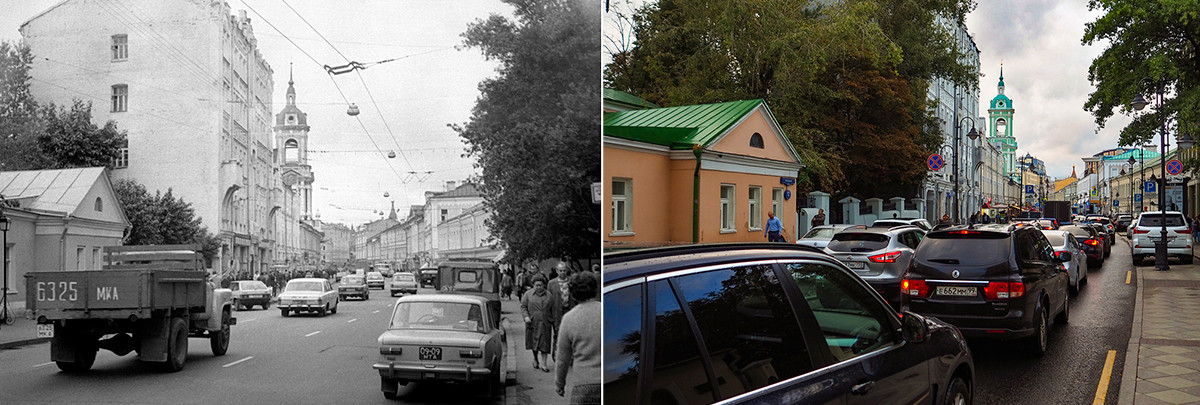
Pyatnitskaya Street (June 1, 1988 - Aug. 30, 1991) / 2020
Find on map
1972: Chugunny Bridge
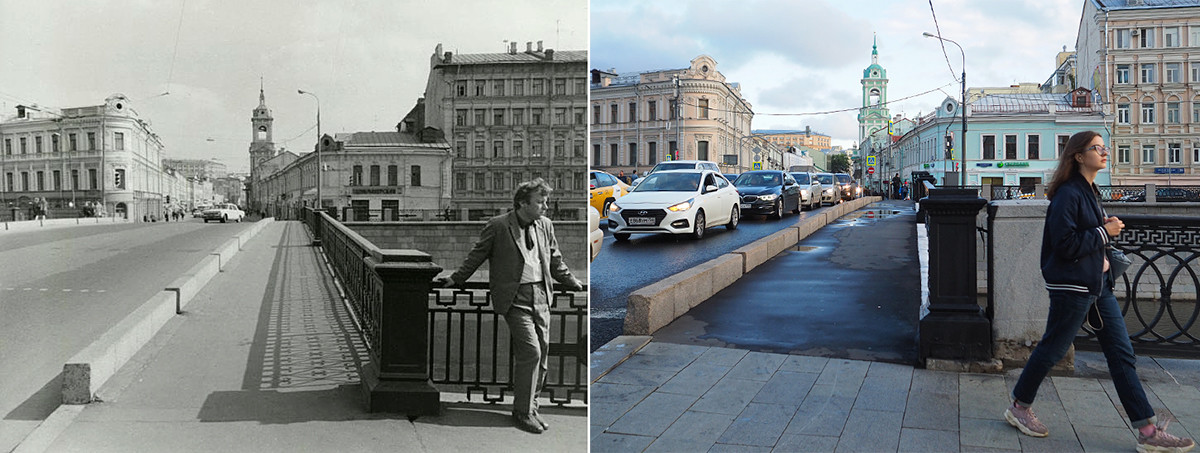
View of Pyatnitskaya Street from Chugunny Bridge (June 11, 1972) / 2020
1994: Pyatnitskaya Street
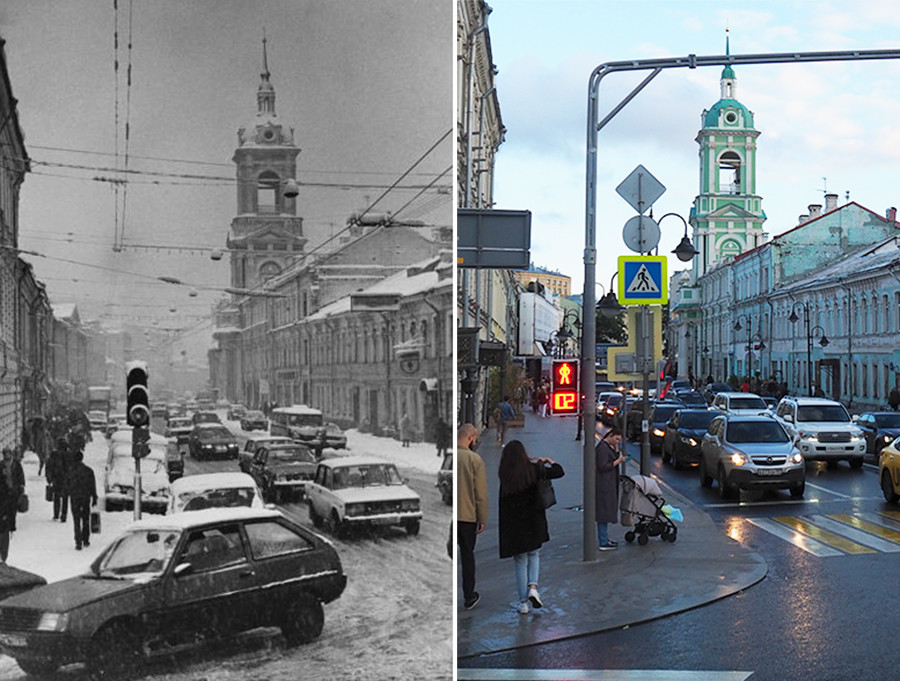
View of Pyatnitskaya Street (Feb. 1994) / 2020
1963: Monument to the Conquerors of Space
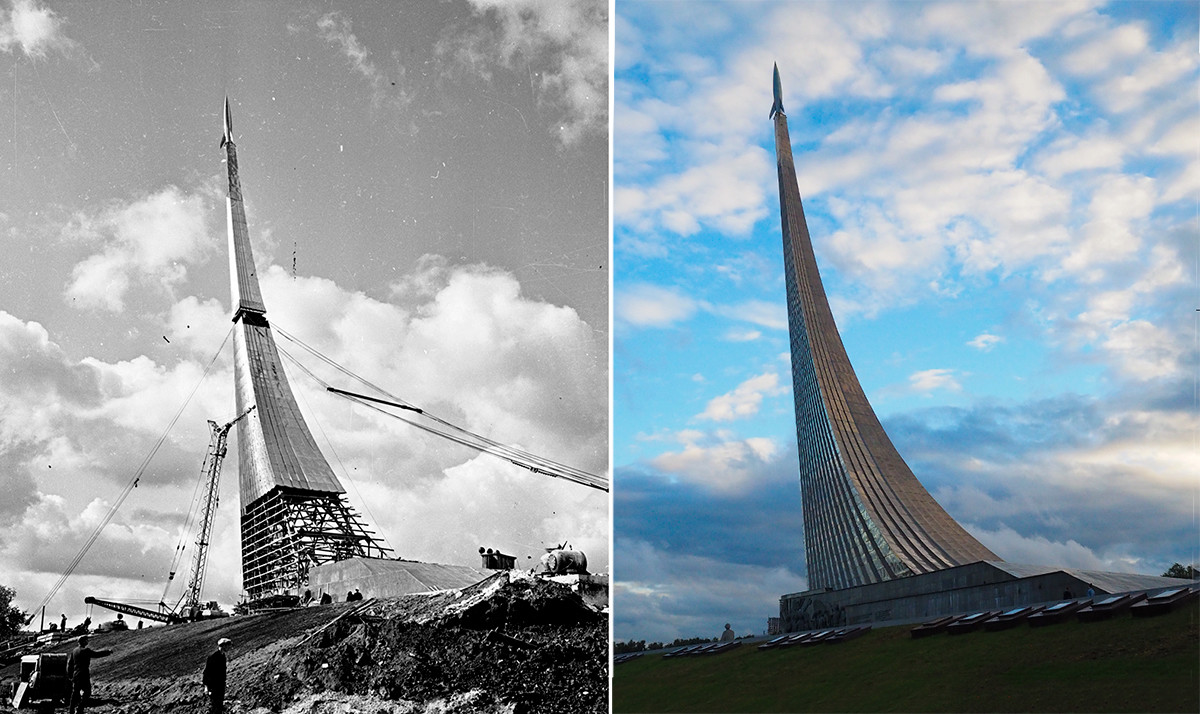
Monument to the Conquerors of Space during construction (1963) / 2020
1956: Main entrance to VDNKh
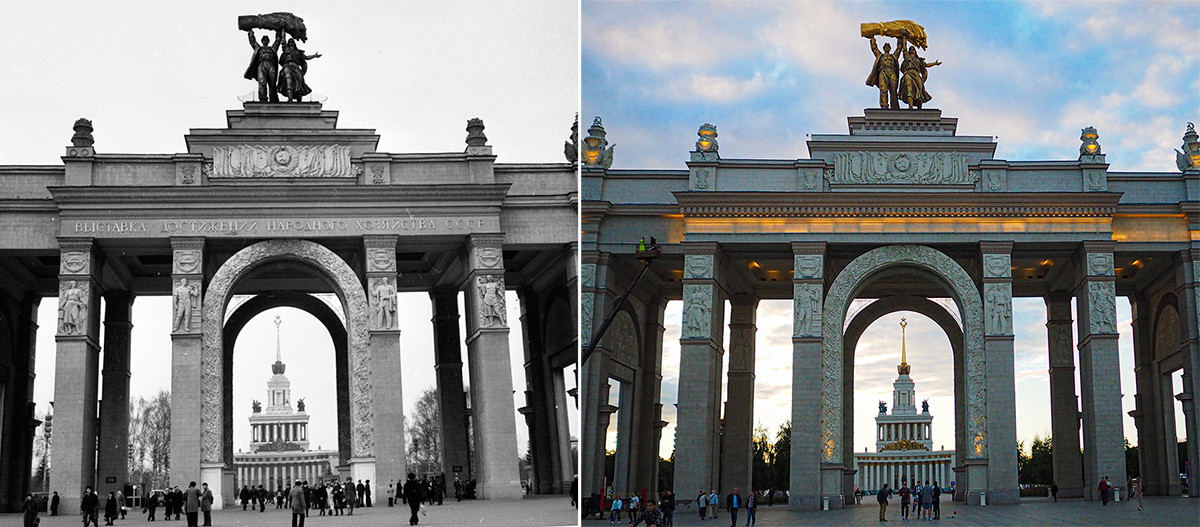
Main entrance to VDNKh (March 15, 1956) / 2020
1940: Worker and Kolkhoz Woman
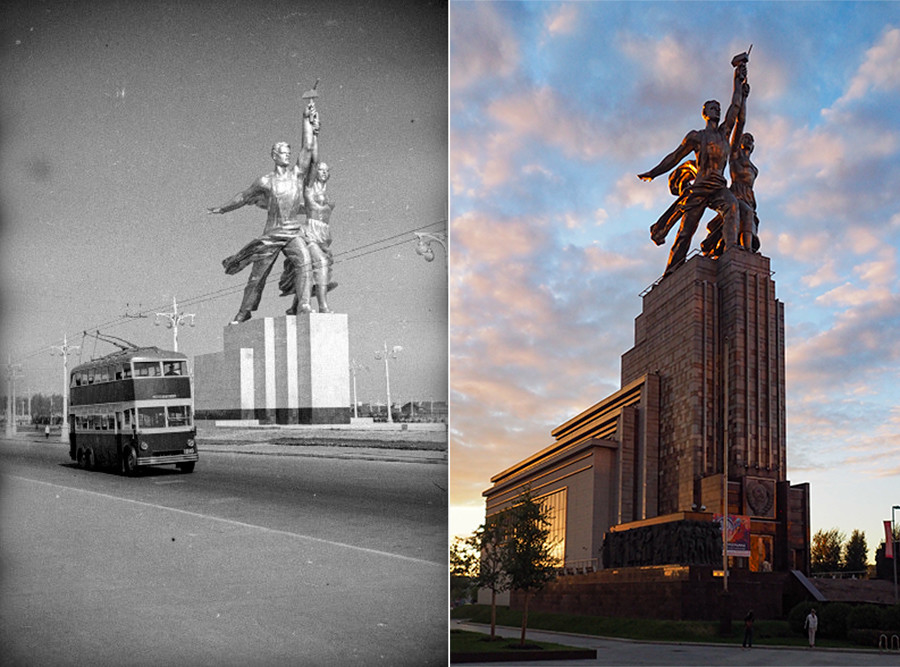
Worker and Kolkhoz Woman. Sculpture by Vera Mukhina. (1940) / 2020

1991: View of Bolotnaya Square

Moscow streets in the late 1980s (June 1, 1988 - Aug. 30, 1991) / 2020
1880s: View of the Kremlin from Sofiyskaya Embankment

View of the Kremlin from Sofiyskaya Embankment (1878-1883) / 2020
1970s: Rossiya Hotel / Zaryadye Park

View of the Moskva River with Hotel Rossiya and the Concert Hall (1970s) / 2020
The enormous hotel was built in the 1960s and dismantled in 2006. Zaryadye Park was built on the site.
1890s: Pashkov House
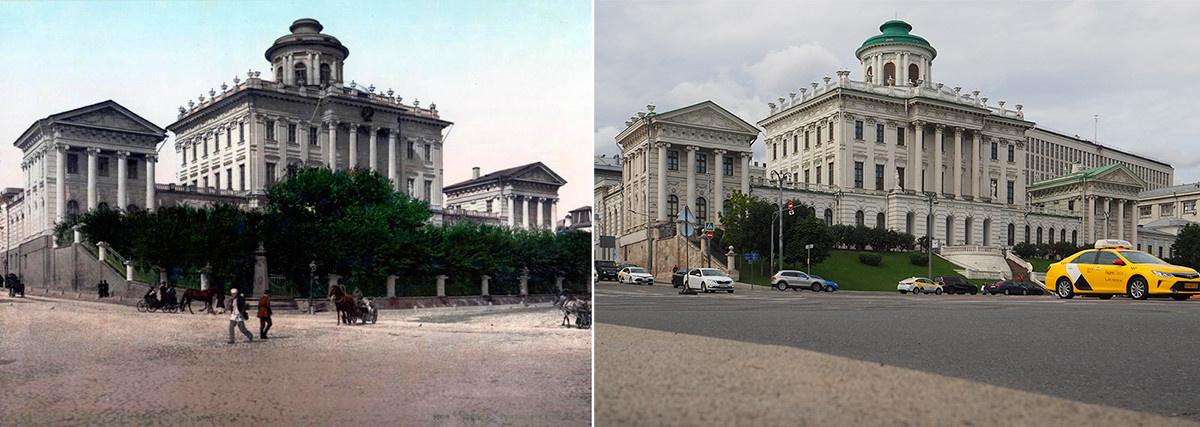
Pashkov House (1897-1898) / 2020
In 1831, a museum was opened in Nikolay Rumyantsev's mansion on the Angliyskaya (English) Embankment in St. Petersburg. In 1861, the museum was transferred to Moscow. It was installed in the Pashkov House and merged with the Moscow Public Museum.
1880s: Cathedral of Christ the Savior
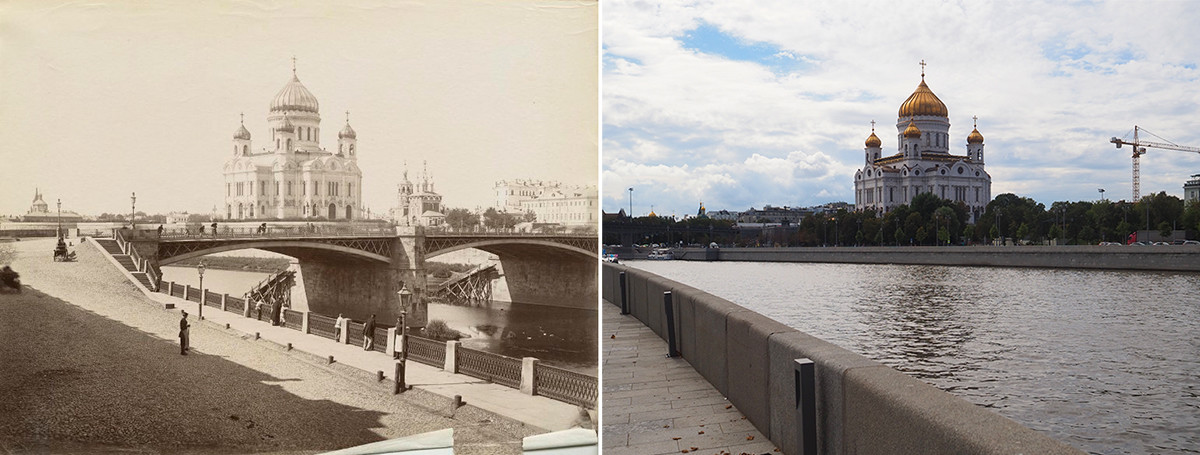
View of the Cathedral of Christ the Savior and Church of Praise to the Blessed Virgin Mary in Bashmaki from the Bersenevskaya Embankment (1880s) / 2020
The original cathedral, left of photo, was demolished in 1931 as part of the plan for reconstructing Moscow under Stalin. The present cathedral had been rebuilt by 1999. The Church of Praise to the Blessed Virgin Mary has not been rebuilt.
1933: Krymsky Bridge

Panoramic view of Bolshoy Krymsky Bridge during construction (1933) / 2020
1955: Entrance to Gorky Park
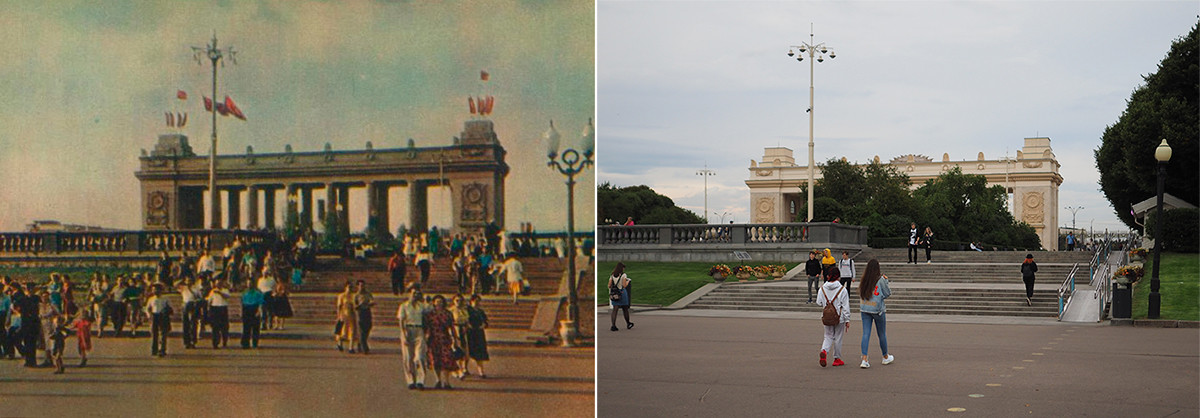
Entrance to Gorky Central Park of Culture and Leisure (1955) / 2020
1893: House of the Merchant Igumnov
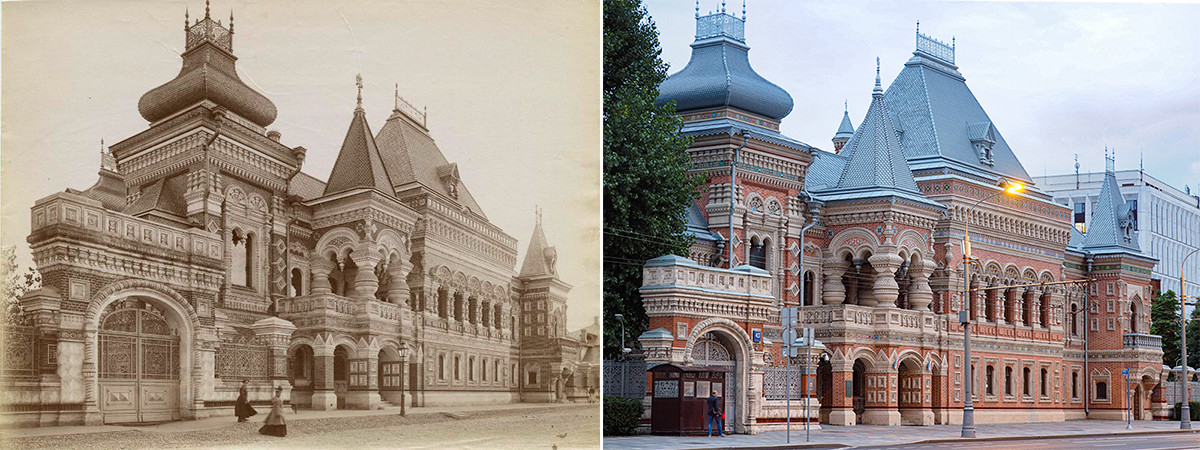
House of the Merchant Igumnov in Moscow (1893) / 2020
1890s: GUM Department Store
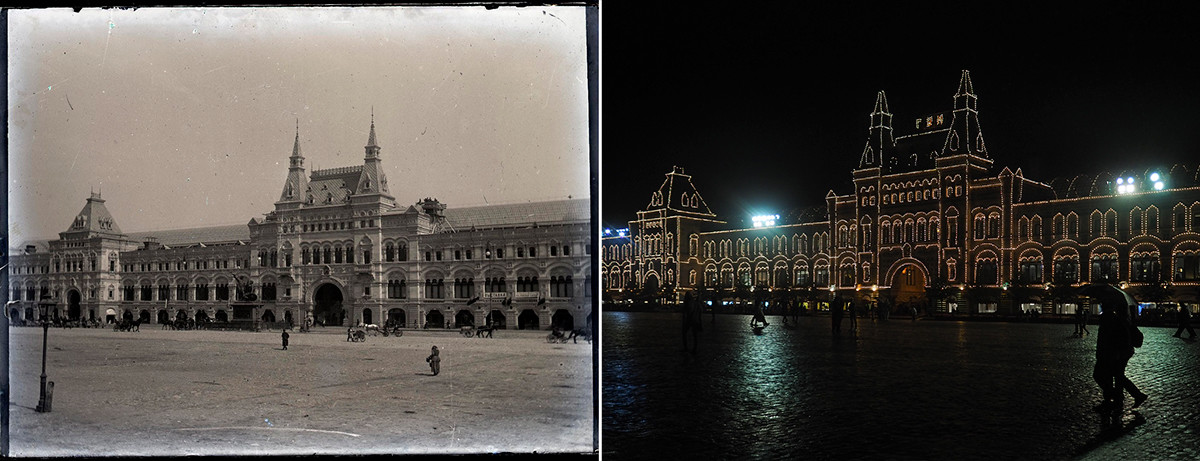
Upper Trading Rows (1890-1900) / 2020
1896: Teatralnaya (Theater) Square
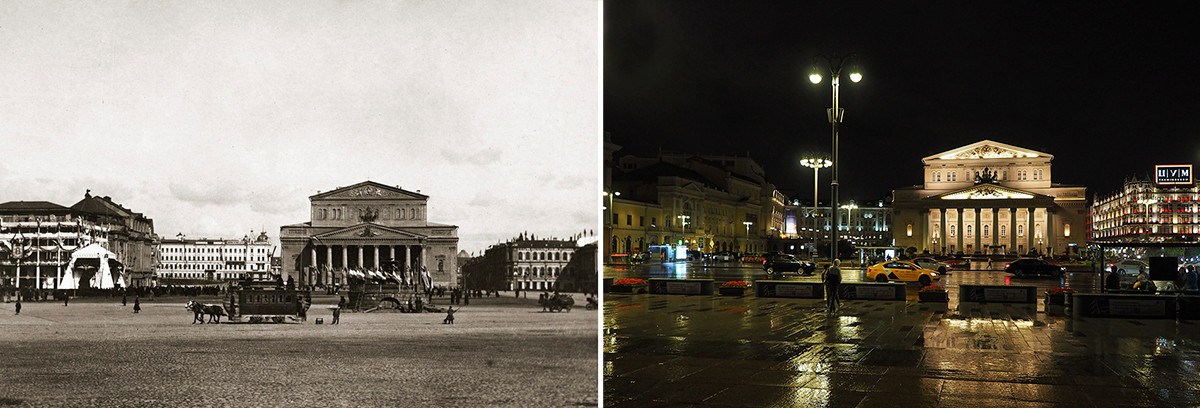
Teatralnaya Square during the Coronation of Nicholas II (May 1896) / 2020
About the photo: The Coronation of Emperor Nicholas II Aleksandrovich and Empress Alexandra Feodorovna took place on Tuesday, May 14 (May 26 in the current calendar), 1896, in the Moscow Kremlin’s Cathedral of the Dormition.
1980s: Church of St. John the Warrior
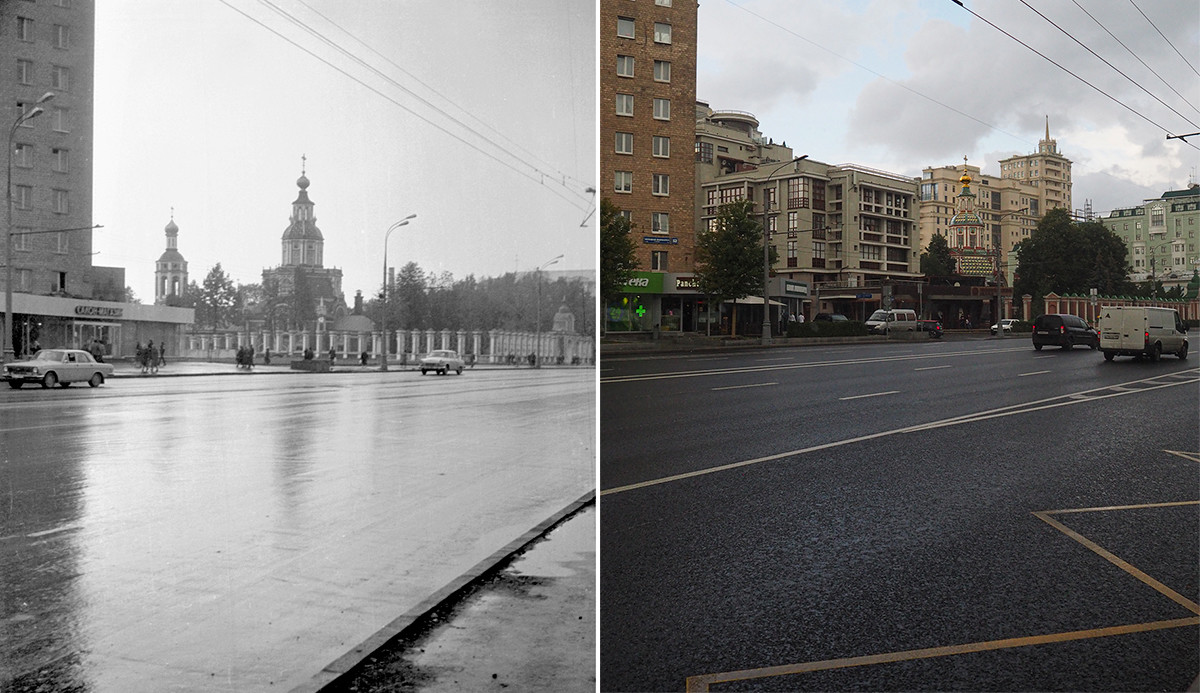
Church of St. John the Warrior (May 1, 1984 - Oct. 31, 1985) / 2020
If using any of Russia Beyond's content, partly or in full, always provide an active hyperlink to the original material.
to our newsletter!
Get the week's best stories straight to your inbox
- 10 LOST architectural wonders of Moscow (PHOTOS)
- How many days in Moscow is enough?
- 10 Moscow street names that baffle even locals
This website uses cookies. Click here to find out more.
Tourism Web Portal
About the portal.
A technological tool for effective communication between the leading players in the Moscow tourism market and representatives of the foreign/regional tourism industry through online events. OBJECTIVES: • Building long-term cooperation with foreign/regional representatives • Raising awareness among foreign/regional representatives of the tourism industry of the tourism opportunities, measures and attractiveness of the city of Moscow in the field of tourist infrastructure development
Moscow City Tourism Committee
The Tourism Committee, or Mostourism, is the executive body of the Moscow City Government that oversees tourist activities in the capital. The Committee is responsible for legislative initiatives, congress and exhibition activities, and event and image projects. As the brand manager for an attractive tourism image for Moscow, Mostourism constantly analyses global trends, offers Russian and foreign tourists what they want, and also uncovers new opportunities for the capital in terms of interesting and rewarding leisure activities.
ANO «Project Office for the Development of Tourism and Hospitality of Moscow»
Syundyukova Yulia [email protected] Mezhiev Magomed [email protected]
Video materials about Moscow
2018 Primetime Emmy & James Beard Award Winner
In Transit: Notes from the Underground
Jun 06 2018.
Spend some time in one of Moscow’s finest museums.
Subterranean commuting might not be anyone’s idea of a good time, but even in a city packing the war-games treasures and priceless bejeweled eggs of the Kremlin Armoury and the colossal Soviet pavilions of the VDNKh , the Metro holds up as one of Moscow’s finest museums. Just avoid rush hour.
The Metro is stunning and provides an unrivaled insight into the city’s psyche, past and present, but it also happens to be the best way to get around. Moscow has Uber, and the Russian version called Yandex Taxi , but also some nasty traffic. Metro trains come around every 90 seconds or so, at a more than 99 percent on-time rate. It’s also reasonably priced, with a single ride at 55 cents (and cheaper in bulk). From history to tickets to rules — official and not — here’s what you need to know to get started.
A Brief Introduction Buying Tickets Know Before You Go (Down) Rules An Easy Tour
A Brief Introduction
Moscow’s Metro was a long time coming. Plans for rapid transit to relieve the city’s beleaguered tram system date back to the Imperial era, but a couple of wars and a revolution held up its development. Stalin revived it as part of his grand plan to modernize the Soviet Union in the 1920s and 30s. The first lines and tunnels were constructed with help from engineers from the London Underground, although Stalin’s secret police decided that they had learned too much about Moscow’s layout and had them arrested on espionage charges and deported.
The beauty of its stations (if not its trains) is well-documented, and certainly no accident. In its illustrious first phases and particularly after the Second World War, the greatest architects of Soviet era were recruited to create gleaming temples celebrating the Revolution, the USSR, and the war triumph. No two stations are exactly alike, and each of the classic showpieces has a theme. There are world-famous shrines to Futurist architecture, a celebration of electricity, tributes to individuals and regions of the former Soviet Union. Each marble slab, mosaic tile, or light fixture was placed with intent, all in service to a station’s aesthetic; each element, f rom the smallest brass ear of corn to a large blood-spattered sword on a World War II mural, is an essential part of the whole.

The Metro is a monument to the Soviet propaganda project it was intended to be when it opened in 1935 with the slogan “Building a Palace for the People”. It brought the grand interiors of Imperial Russia to ordinary Muscovites, celebrated the Soviet Union’s past achievements while promising its citizens a bright Soviet future, and of course, it was a show-piece for the world to witness the might and sophistication of life in the Soviet Union.
It may be a museum, but it’s no relic. U p to nine million people use it daily, more than the London Underground and New York Subway combined. (Along with, at one time, about 20 stray dogs that learned to commute on the Metro.)
In its 80+ year history, the Metro has expanded in phases and fits and starts, in step with the fortunes of Moscow and Russia. Now, partly in preparation for the World Cup 2018, it’s also modernizing. New trains allow passengers to walk the entire length of the train without having to change carriages. The system is becoming more visitor-friendly. (There are helpful stickers on the floor marking out the best selfie spots .) But there’s a price to modernity: it’s phasing out one of its beloved institutions, the escalator attendants. Often they are middle-aged or elderly women—“ escalator grandmas ” in news accounts—who have held the post for decades, sitting in their tiny kiosks, scolding commuters for bad escalator etiquette or even bad posture, or telling jokes . They are slated to be replaced, when at all, by members of the escalator maintenance staff.
For all its achievements, the Metro lags behind Moscow’s above-ground growth, as Russia’s capital sprawls ever outwards, generating some of the world’s worst traffic jams . But since 2011, the Metro has been in the middle of an ambitious and long-overdue enlargement; 60 new stations are opening by 2020. If all goes to plan, the 2011-2020 period will have brought 125 miles of new tracks and over 100 new stations — a 40 percent increase — the fastest and largest expansion phase in any period in the Metro’s history.
Facts: 14 lines Opening hours: 5 a.m-1 a.m. Rush hour(s): 8-10 a.m, 4-8 p.m. Single ride: 55₽ (about 85 cents) Wi-Fi network-wide

Buying Tickets
- Ticket machines have a button to switch to English.
- You can buy specific numbers of rides: 1, 2, 5, 11, 20, or 60. Hold up fingers to show how many rides you want to buy.
- There is also a 90-minute ticket , which gets you 1 trip on the metro plus an unlimited number of transfers on other transport (bus, tram, etc) within 90 minutes.
- Or, you can buy day tickets with unlimited rides: one day (218₽/ US$4), three days (415₽/US$7) or seven days (830₽/US$15). Check the rates here to stay up-to-date.
- If you’re going to be using the Metro regularly over a few days, it’s worth getting a Troika card , a contactless, refillable card you can use on all public transport. Using the Metro is cheaper with one of these: a single ride is 36₽, not 55₽. Buy them and refill them in the Metro stations, and they’re valid for 5 years, so you can keep it for next time. Or, if you have a lot of cash left on it when you leave, you can get it refunded at the Metro Service Centers at Ulitsa 1905 Goda, 25 or at Staraya Basmannaya 20, Building 1.
- You can also buy silicone bracelets and keychains with built-in transport chips that you can use as a Troika card. (A Moscow Metro Fitbit!) So far, you can only get these at the Pushkinskaya metro station Live Helpdesk and souvenir shops in the Mayakovskaya and Trubnaya metro stations. The fare is the same as for the Troika card.
- You can also use Apple Pay and Samsung Pay.
Rules, spoken and unspoken
No smoking, no drinking, no filming, no littering. Photography is allowed, although it used to be banned.
Stand to the right on the escalator. Break this rule and you risk the wrath of the legendary escalator attendants. (No shenanigans on the escalators in general.)
Get out of the way. Find an empty corner to hide in when you get off a train and need to stare at your phone. Watch out getting out of the train in general; when your train doors open, people tend to appear from nowhere or from behind ornate marble columns, walking full-speed.
Always offer your seat to elderly ladies (what are you, a monster?).
An Easy Tour
This is no Metro Marathon ( 199 stations in 20 hours ). It’s an easy tour, taking in most—though not all—of the notable stations, the bulk of it going clockwise along the Circle line, with a couple of short detours. These stations are within minutes of one another, and the whole tour should take about 1-2 hours.
Start at Mayakovskaya Metro station , at the corner of Tverskaya and Garden Ring, Triumfalnaya Square, Moskva, Russia, 125047.
1. Mayakovskaya. Named for Russian Futurist Movement poet Vladimir Mayakovsky and an attempt to bring to life the future he imagined in his poems. (The Futurist Movement, natch, was all about a rejecting the past and celebrating all things speed, industry, modern machines, youth, modernity.) The result: an Art Deco masterpiece that won the National Grand Prix for architecture at the New York World’s Fair in 1939. It’s all smooth, rounded shine and light, and gentle arches supported by columns of dark pink marble and stainless aircraft steel. Each of its 34 ceiling niches has a mosaic. During World War II, the station was used as an air-raid shelter and, at one point, a bunker for Stalin. He gave a subdued but rousing speech here in Nov. 6, 1941 as the Nazis bombed the city above.

Take the 3/Green line one station to:
2. Belorusskaya. Opened in 1952, named after the connected Belarussky Rail Terminal, which runs trains between Moscow and Belarus. This is a light marble affair with a white, cake-like ceiling, lined with Belorussian patterns and 12 Florentine ceiling mosaics depicting life in Belarussia when it was built.

Transfer onto the 1/Brown line. Then, one stop (clockwise) t o:
3. Novoslobodskaya. This station was designed around the stained-glass panels, which were made in Latvia, because Alexey Dushkin, the Soviet starchitect who dreamed it up (and also designed Mayakovskaya station) couldn’t find the glass and craft locally. The stained glass is the same used for Riga’s Cathedral, and the panels feature plants, flowers, members of the Soviet intelligentsia (musician, artist, architect) and geometric shapes.

Go two stops east on the 1/Circle line to:
4. Komsomolskaya. Named after the Komsomol, or the Young Communist League, this might just be peak Stalin Metro style. Underneath the hub for three regional railways, it was intended to be a grand gateway to Moscow and is today its busiest station. It has chandeliers; a yellow ceiling with Baroque embellishments; and in the main hall, a colossal red star overlaid on golden, shimmering tiles. Designer Alexey Shchusev designed it as an homage to the speech Stalin gave at Red Square on Nov. 7, 1941, in which he invoked Russia’s illustrious military leaders as a pep talk to Soviet soldiers through the first catastrophic year of the war. The station’s eight large mosaics are of the leaders referenced in the speech, such as Alexander Nevsky, a 13th-century prince and military commander who bested German and Swedish invading armies.

One more stop clockwise to Kurskaya station, and change onto the 3/Blue line, and go one stop to:
5. Baumanskaya. Opened in 1944. Named for the Bolshevik Revolutionary Nikolai Bauman , whose monument and namesake district are aboveground here. Though he seemed like a nasty piece of work (he apparently once publicly mocked a woman he had impregnated, who later hung herself), he became a Revolutionary martyr when he was killed in 1905 in a skirmish with a monarchist, who hit him on the head with part of a steel pipe. The station is in Art Deco style with atmospherically dim lighting, and a series of bronze sculptures of soldiers and homefront heroes during the War. At one end, there is a large mosaic portrait of Lenin.

Stay on that train direction one more east to:
6. Elektrozavodskaya. As you may have guessed from the name, this station is the Metro’s tribute to all thing electrical, built in 1944 and named after a nearby lightbulb factory. It has marble bas-relief sculptures of important figures in electrical engineering, and others illustrating the Soviet Union’s war-time struggles at home. The ceiling’s recurring rows of circular lamps give the station’s main tunnel a comforting glow, and a pleasing visual effect.

Double back two stops to Kurskaya station , and change back to the 1/Circle line. Sit tight for six stations to:
7. Kiyevskaya. This was the last station on the Circle line to be built, in 1954, completed under Nikita Khrushchev’ s guidance, as a tribute to his homeland, Ukraine. Its three large station halls feature images celebrating Ukraine’s contributions to the Soviet Union and Russo-Ukrainian unity, depicting musicians, textile-working, soldiers, farmers. (One hall has frescoes, one mosaics, and the third murals.) Shortly after it was completed, Khrushchev condemned the architectural excesses and unnecessary luxury of the Stalin era, which ushered in an epoch of more austere Metro stations. According to the legend at least, he timed the policy in part to ensure no Metro station built after could outshine Kiyevskaya.

Change to the 3/Blue line and go one stop west.
8. Park Pobedy. This is the deepest station on the Metro, with one of the world’s longest escalators, at 413 feet. If you stand still, the escalator ride to the surface takes about three minutes .) Opened in 2003 at Victory Park, the station celebrates two of Russia’s great military victories. Each end has a mural by Georgian artist Zurab Tsereteli, who also designed the “ Good Defeats Evil ” statue at the UN headquarters in New York. One mural depicts the Russian generals’ victory over the French in 1812 and the other, the German surrender of 1945. The latter is particularly striking; equal parts dramatic, triumphant, and gruesome. To the side, Red Army soldiers trample Nazi flags, and if you look closely there’s some blood spatter among the detail. Still, the biggest impressions here are the marble shine of the chessboard floor pattern and the pleasingly geometric effect if you view from one end to the other.

Keep going one more stop west to:
9. Slavyansky Bulvar. One of the Metro’s youngest stations, it opened in 2008. With far higher ceilings than many other stations—which tend to have covered central tunnels on the platforms—it has an “open-air” feel (or as close to it as you can get, one hundred feet under). It’s an homage to French architect Hector Guimard, he of the Art Nouveau entrances for the Paris M é tro, and that’s precisely what this looks like: A Moscow homage to the Paris M é tro, with an additional forest theme. A Cyrillic twist on Guimard’s Metro-style lettering over the benches, furnished with t rees and branch motifs, including creeping vines as towering lamp-posts.

Stay on the 3/Blue line and double back four stations to:
10. Arbatskaya. Its first iteration, Arbatskaya-Smolenskaya station, was damaged by German bombs in 1941. It was rebuilt in 1953, and designed to double as a bomb shelter in the event of nuclear war, although unusually for stations built in the post-war phase, this one doesn’t have a war theme. It may also be one of the system’s most elegant: Baroque, but toned down a little, with red marble floors and white ceilings with gilded bronze c handeliers.

Jump back on the 3/Blue line in the same direction and take it one more stop:
11. Ploshchad Revolyutsii (Revolution Square). Opened in 1938, and serving Red Square and the Kremlin . Its renowned central hall has marble columns flanked by 76 bronze statues of Soviet heroes: soldiers, students, farmers, athletes, writers, parents. Some of these statues’ appendages have a yellow sheen from decades of Moscow’s commuters rubbing them for good luck. Among the most popular for a superstitious walk-by rub: the snout of a frontier guard’s dog, a soldier’s gun (where the touch of millions of human hands have tapered the gun barrel into a fine, pointy blade), a baby’s foot, and a woman’s knee. (A brass rooster also sports the telltale gold sheen, though I am told that rubbing the rooster is thought to bring bad luck. )
Now take the escalator up, and get some fresh air.

R&K Insider
Join our newsletter to get exclusives on where our correspondents travel, what they eat, where they stay. Free to sign up.
21 Things to Know Before You Go to Moscow
Featured city guides.

IMAGES
VIDEO
COMMENTS
1907 Norton. The 1907 Isle of Man TT races were the inaugural International Tourist Trophy for motor-cycles held on the Isle of Man.The event was held on Tuesday 28 May 1907 over the St John's Short Course consisting of a Single Cylinder and a Twin-Cylinder class. The race was ten laps of the 15 mile 1,430 yards course, a total race distance of 158 miles 220 yards (226.071 km).
More than 100 years on and thrill seekers still venture to the Isle of Man every summer for the same reason the gentlemen of 1907 did, the Tourist Trophy more commonly known as the Isle of Man TT. It was the spirit of competition and advancement that brought the original TT competition to the Island ...
The Isle of Man TT or Tourist Trophy races are an annual motorcycle racing event run on the Isle of Man in May and June of most years since its inaugural race in 1907.The event begins on the UK Spring Bank Holiday at the end of May and runs for thirteen days. It is often called one of the most dangerous racing events in the world as many competitors have died.
TT 1907. Frank Hulbert and Jack Marshall cannot have realised the significance of the moment as they pointed their single-cylinder motorcycles up the dusty track towards Ballacraine at 10 am on the cold, cloudy morning of 28 May 1907. The Isle of Man Tourist Trophy races were born as the two Triumphs spluttered into life to start their 158-mile ...
On a dry but cold day back in May 1907, twenty-five competitors gathered at Tynwald Hill for the first race in the 'International Auto-Cycle Tourist Trophy'. First over the finish line was ...
TT Race HistoryA hundred years on and thrill seekers still venture to the Isle of Man every summer for the same reason the gentlemen of 1907 did, the Tourist Trophy more commonly known as the Isle ...
The TT (Tourist Trophy) motorcycle races have given the Isle of Man an international reputation as being the Road Racing Capital of the World. The first TT Races were held in 1907 at St John's with 27 competitors racing 10 bone-shaking laps of a 15 mile circuit of public roads. In 1911 this short circuit was replaced by the 37½ mile Mountain ...
The first ever TT was held in 1907 thanks to the 1904 Isle of Man Parliament Act that permitted road racing. ... organized the inaugural race, known as the Auto Cycle Tourist Trophy, a 10-lap race ...
The Isle of Man Tourist Trophy is one of the few remaining untamed road races on the planet. If you were to pitch it anew in the year 2021 you'd be laughed right out of the planning meeting; fatalities have averaged more than one a year since the first race in 1907. Yet year after year, it attracts an enormous roster of both road-racing ...
The 1907 Isle of Man TT races were the inaugural International Tourist Trophy for motor-cycles held on the Isle of Man. The event was held on Tuesday 28 May 1907 over the St John's Short Course consisting of a Single Cylinder and a Twin-Cylinder class. The race was ten laps of the 15 mile 1,430 yards course, a total race distance of 158 miles 220 yards .
Profile, history, period photos and information about the Royal Automobile Club Tourist Trophy, the oldest motor race in the world still being run. ... In 1907, the RAC ran two races, one for ...
Tourist Trophy races, best known and most demanding of the European motorcycle races. First run in 1907 on the Isle of Man off the northwestern coast of England, the race attracted many riders from all over England and the European continent. The race was originally intended for motorcycles "similar to those sold to the public," called touring machines, and soon became known as the Tourist ...
1907 Isle of Man TT - first motorcycle race. On a dry but cold day back in May 1907, twenty-five competitors gathered at Tynwald Hill for the first race in the 'International Auto-Cycle Tourist Trophy'. This is Harry Rembrandt Fowler (1882-1963), popularly known as 'Rem', alongside his famous Peugeot-powered Norton motorbike, upon which ...
Tourist Trophy Racing Ramsey: Lily Publications, 2007 ISBN 1-899602-67-4 Library Ref C498/227q Harris, Nick Motocourse History of the Isle of Man Tourist Trophy Races 1907-1989 Richmond: Hazleton Publishing, 1990 ISBN -905138-71-6 Useful appendix of the first 10 finishers in each race. Library Ref C498/75q Higgins, L.R. & Quantrill, C.
1907 Tourist Trophy Race. The third Tourist Trophy Race was held in the Isle of Man on the 31st May 1907. Friday. The race was won by Ernest Courtis in a 20hp Rover. The 'Graphic' Trophy Race was also held on Slein Lewaigne Hill, near Ramsey over a hill climbing course of 2,550 yards. Barwick (Daimler) crashed in practice on Thursday.
CURRENT SERIES/EVENTS / Motorcycles / Isle of Man Tourist Trophy (1907-to date) Isle of Man Tourist Trophy (1907-to date) 1907 - St John's Course (May 28) Single cyclinder: Charlie Collier (GB)-Matchless Twin cylinder: Rem Fowler (GB)-Norton. 1908 - St John's Course (Sep 22)
Le Tourist Trophy de l'île de Man ou Tourist Trophy (TT) est un événement motocycliste annuel de courses sur route, créé en 1907, qui se déroule sur l'île de Man pendant deux semaines fin mai-début juin. Les courses se déroulent par catégories définies en fonction de la cylindrée et de la motorisation. Épreuve du championnat du monde de vitesse moto depuis sa création en 1949 ...
The Tourist Trophy Races were first held in the Isle of Man in 1907, and consisted of two races, Single Cylinder Class and Twin Cylinder Class. The former was won by C. R. Collier on a 31/2 h.p. Matchless, and the latter by H. R. Fowler on a 5 h.n. Norton. Their speeds were 38.23 m.p.h. and 36.22 m.p.h. respectively.
The Tourist Trophy - 1905-1994. Year Fm.Circuit Winner Nat Car Mph 1905 TC Isle of Man John Napier GB Arrol-Johnston 33.960 1906 TC Isle of Man Charles Rolls GB Rolls-Royce 20hp 39.400 1907 TC Isle of Man Ernest Courtis GB Rover 20hp 28.800 1908 FL Isle of Man W.Watson GB Napier-Hutton 50.300 1914 FL Isle of Man Kenelm Lee Guinness GB Sunbeam ...
Pashkov House (1897-1898) / 2020. Unknown/МАММ/МDF; Mikhail Travkin. In 1831, a museum was opened in Nikolay Rumyantsev's mansion on the Angliyskaya (English) Embankment in St. Petersburg. In ...
About the portal. A technological tool for effective communication between the leading players in the Moscow tourism market and representatives of the foreign/regional tourism industry through online events. OBJECTIVES: • Building long-term cooperation with foreign/regional representatives. • Raising awareness among foreign/regional ...
Just avoid rush hour. The Metro is stunning andprovides an unrivaled insight into the city's psyche, past and present, but it also happens to be the best way to get around. Moscow has Uber, and the Russian version called Yandex Taxi,butalso some nasty traffic. Metro trains come around every 90 seconds or so, at a more than 99 percent on-time ...
There are lots to see in the city centre of Moscow, so we decided to start our series of Russia travel videos by showing you around the most historical part ...